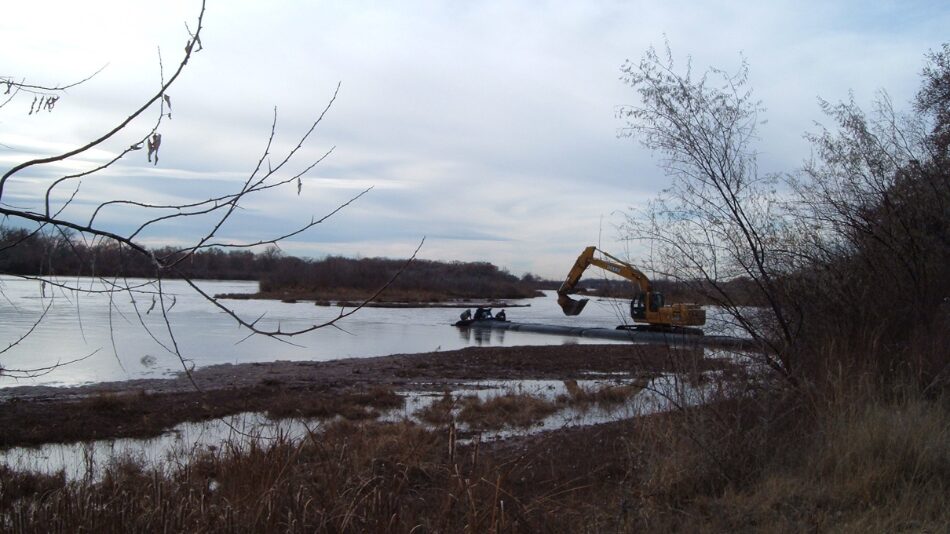
This AquaDam® cofferdam system was installed to de-water a section of the Rio Grande River in order to facilitate the construction of a diversion/intake facility. As part of the facility, a cement foundation was poured to support a pneumatic gate dam. This dam functions by utilizing rubber pouches that inflate and deflate, effectively lifting metal gates that are secured to the top of the foundation.
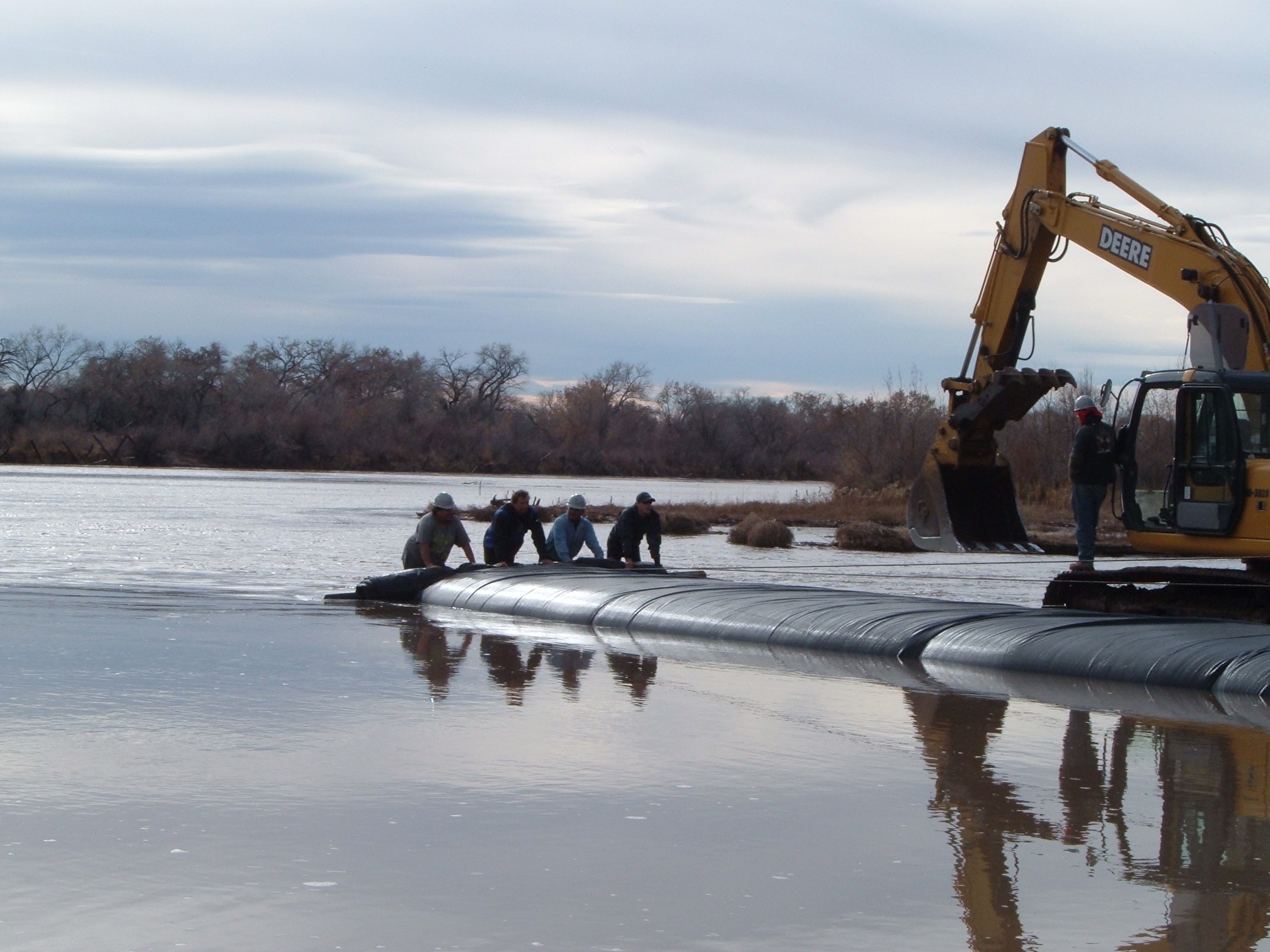
In this photo, the excavator is shown with a guide rope securely fastened to the AquaDam. The rope, in conjunction with the workers, exerted pressure on the AquaDam® to control its direction as it unrolled, ensuring proper alignment and stability throughout the process.
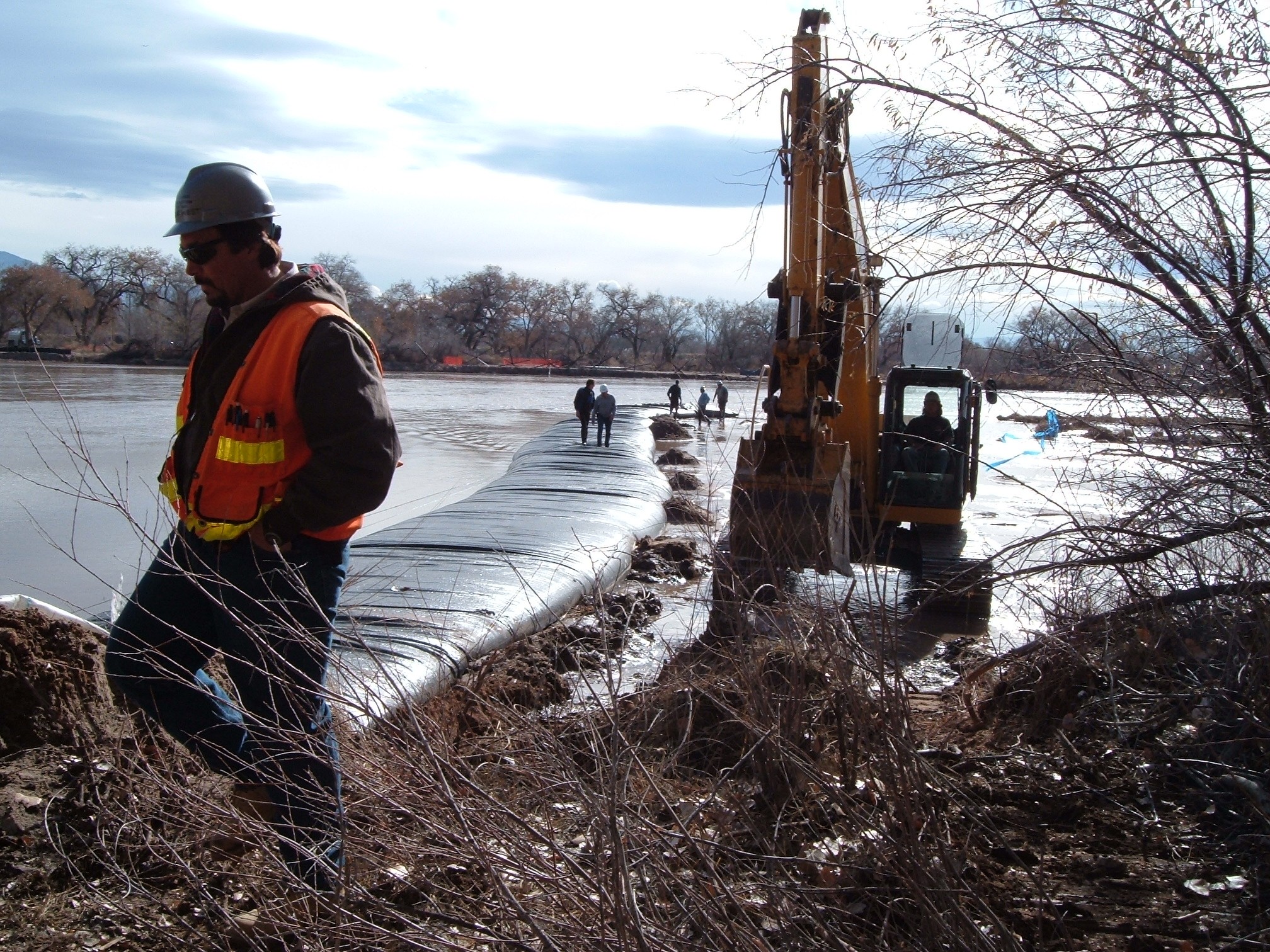
The excavator played a crucial role in positioning and maneuvering the AquaDams during the installation process. Additionally, it was utilized to place mounds of fill on the de-watered side of the dam, providing additional support for the AquaDams.
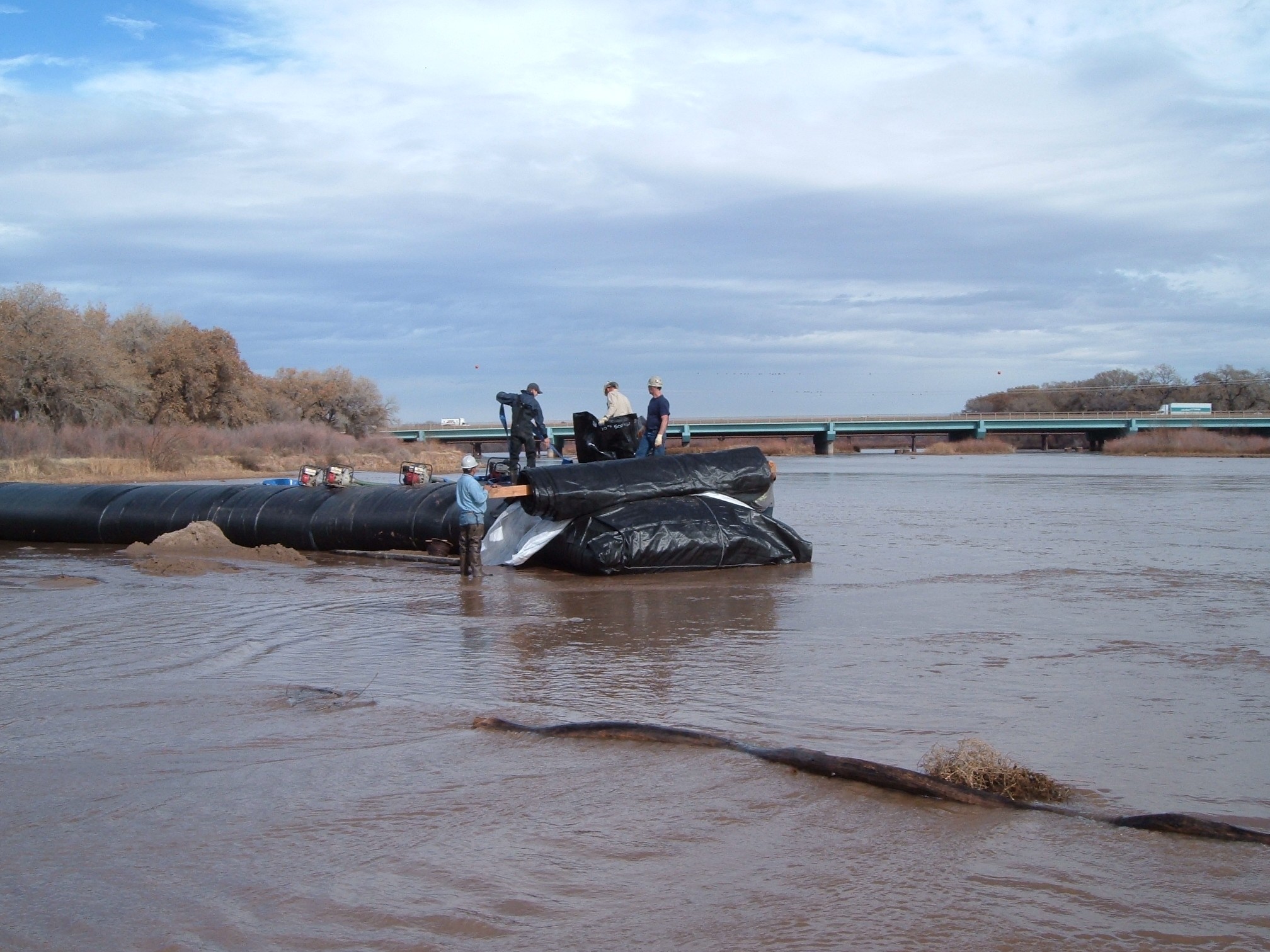
This photo shows workers preparing to join two AquaDams together with a connection collar. AquaDams are delivered in a rolled-up form, similar to a carpet roll on a wooden beam. They are wrapped in a protective covering and include lifting ropes or straps for easy transportation. After the connection is made, the rolled AquaDam® will be filled with water and as it fills it will unroll due to the pressure of the water being pumped into it.

The black tubes extending from the top of the already filled AquaDam® are the fill-tubes of the next dam. The fill-tubes have been pulled through the connection collar, which is attached to the closed end of the filled dam. To ensure proper installation and functionality of a Single Closed End (SCE) AquaDam, it is essential to have a starting bank that maintains a higher elevation than the body of the AquaDam. The open end and fill-tubes of the SCE AquaDam® must remain elevated above the full height of the dam along its designated path. It is important to note that an AquaDam® will only reach its maximum height at the lowest elevation point along its designated path. It is imperative to keep the fill-tubes elevated in order to ensure that the water remains contained within the AquaDam. The closed end of the filled AquaDam® is acting as the starting bank for the next dam.

The second AquaDam® has completely unrolled and is almost full of water.
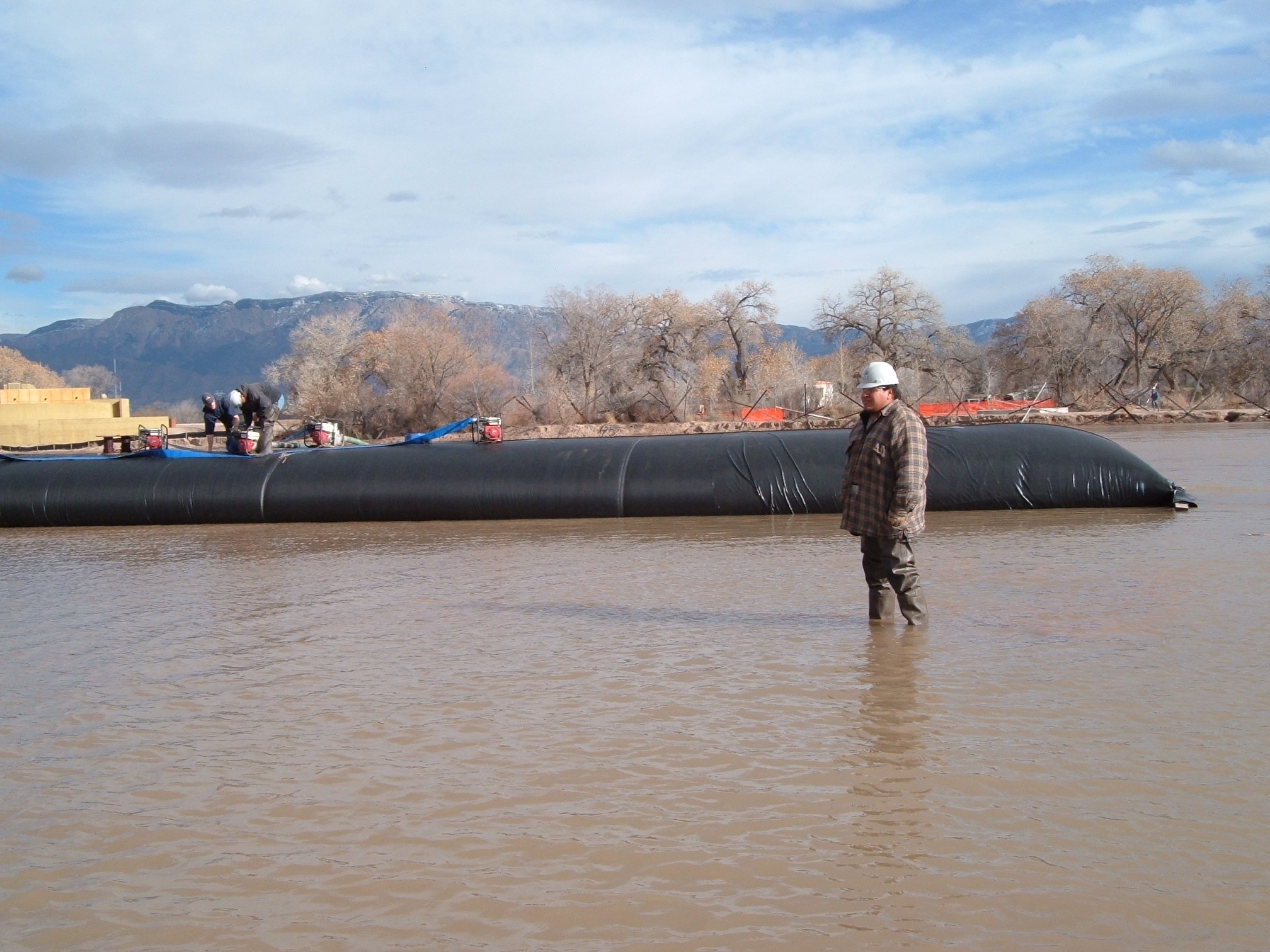
A full AquaDam® provides a platform for workers to walk on and put the pumps on when filling the next AquaDam.
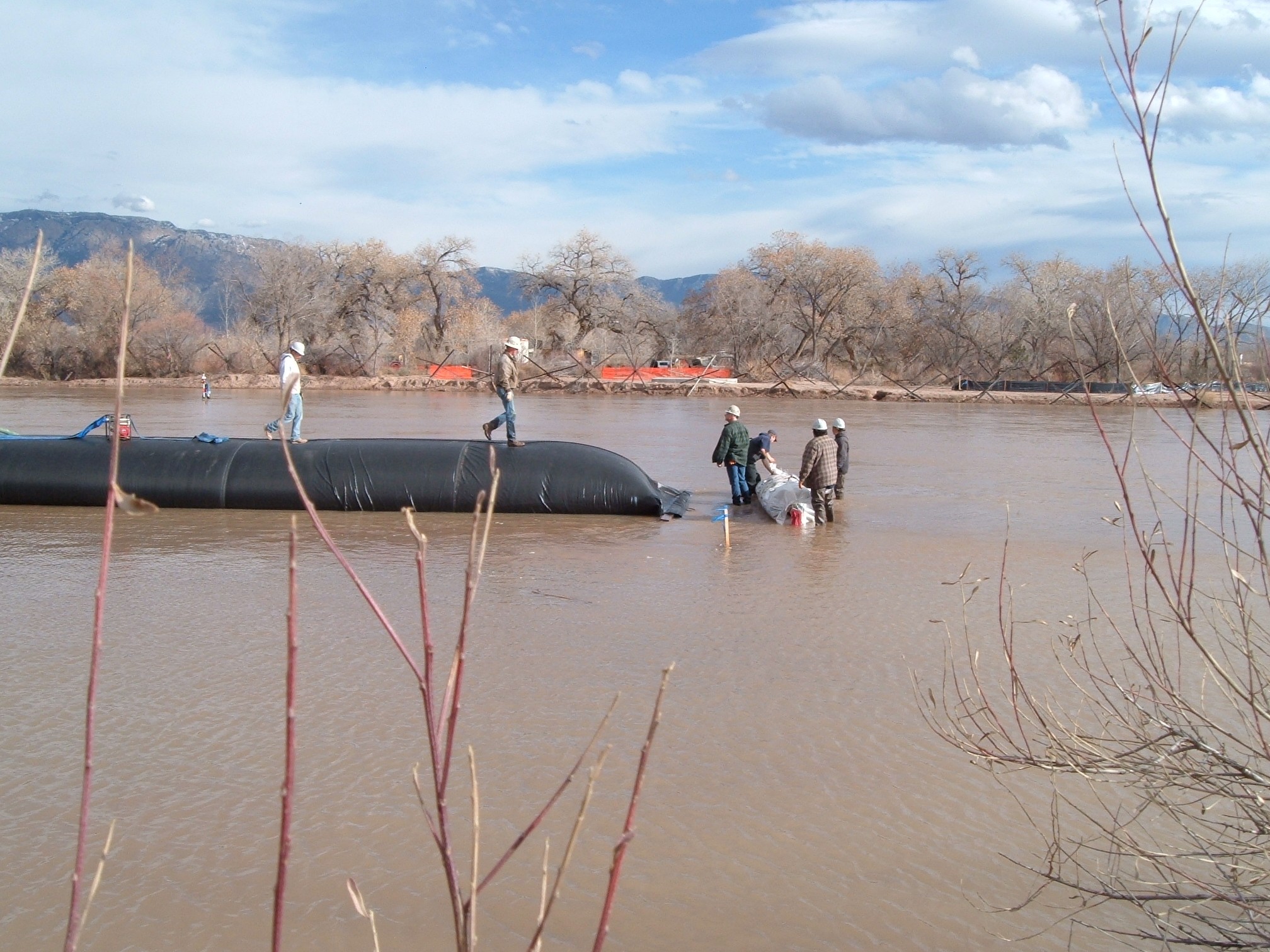
AquaDams used to come wrapped in a white protective covering. Nowadays the protective wrapping is typically black. AquaDams are constructed using lightweight and flexible materials, allowing them to float when empty in deep enough water.

Once the protective wrapping has been removed, the fill-tubes are pushed up through holes cut into the connection collar and the open end of the AquaDam® is positioned up on top of the closed end, inside the collar. The AquaDam® is unrolled beyond the length of the collar, and the collar is stretched to eliminate any wrinkles in the material.

A worker on the filled AquaDam® is installing the discharge hoses into the fill-tubes to begin filling the next dam. Manpower was needed to unroll the AquaDam® in the right direction for the first few feet.
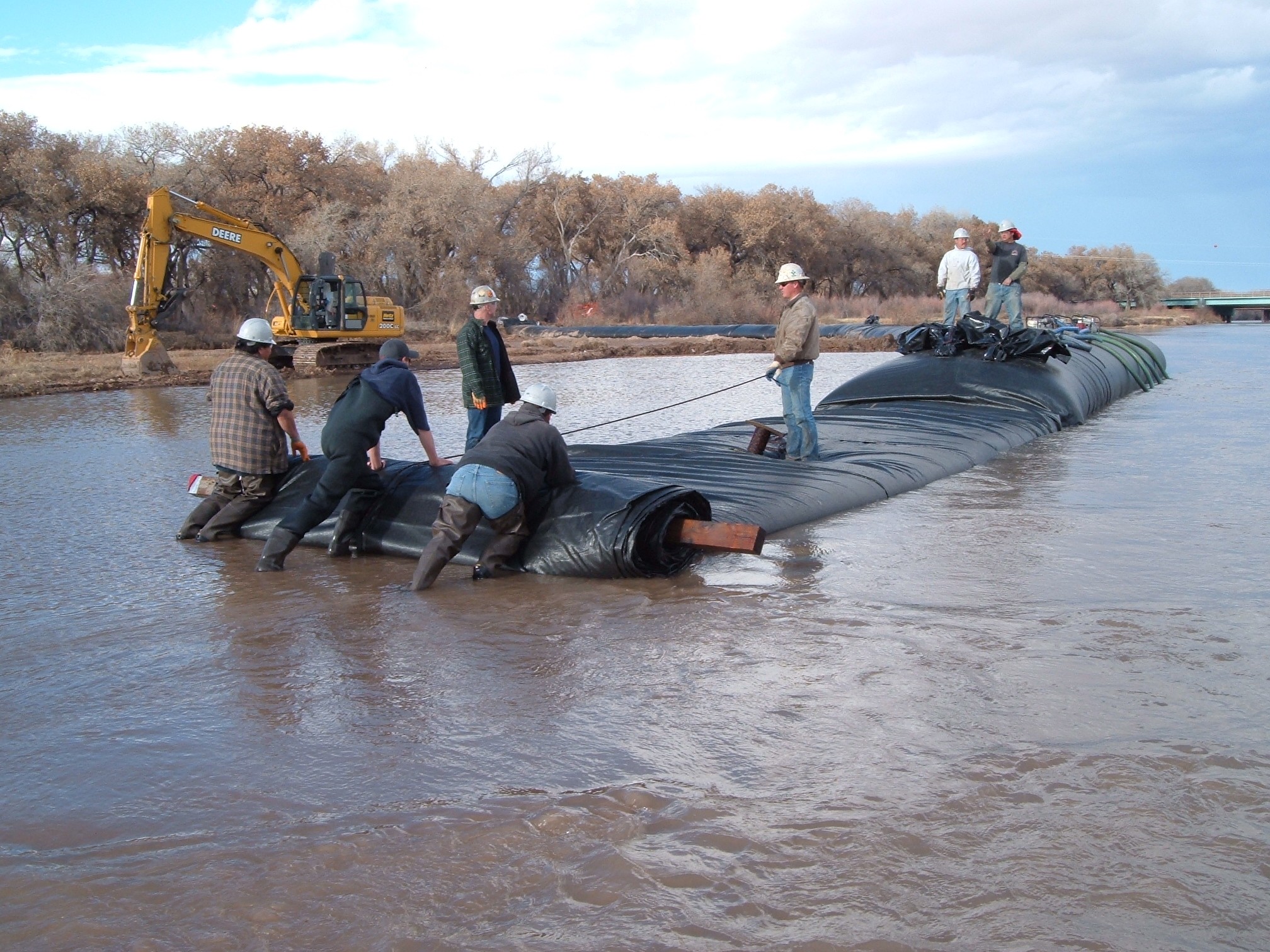
The worker on top of the filling AquaDam® can now guide the end of the dam by rope. The three workers at the end are ensuring the AquaDam® does not unroll too quickly.
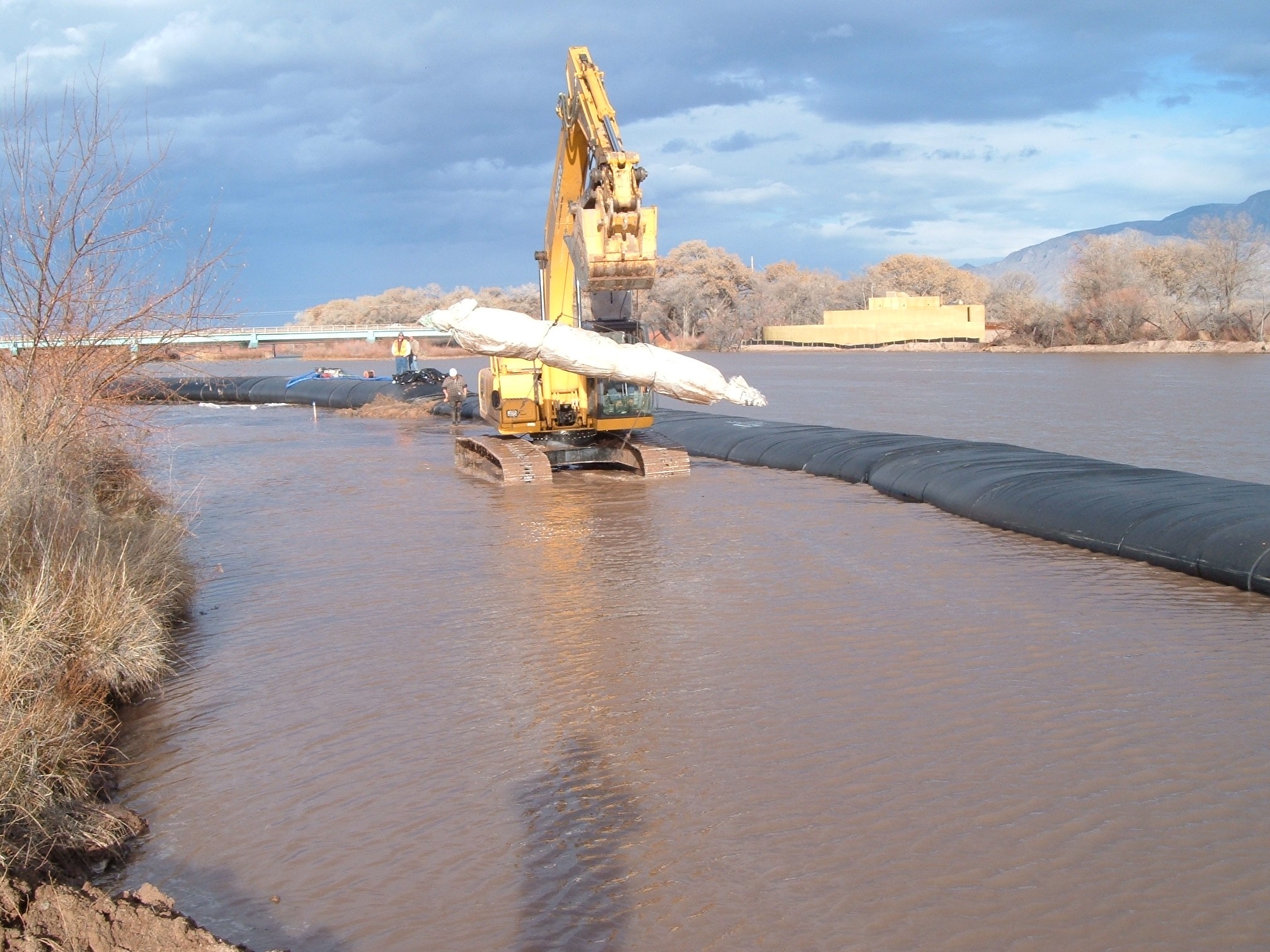
This is one example of how an AquaDam® can be transported within a job site. The AquaDam® is made of material less dense than water, allowing it to float in water and to be easily transported to the desired location before being filled with water to create a barrier.
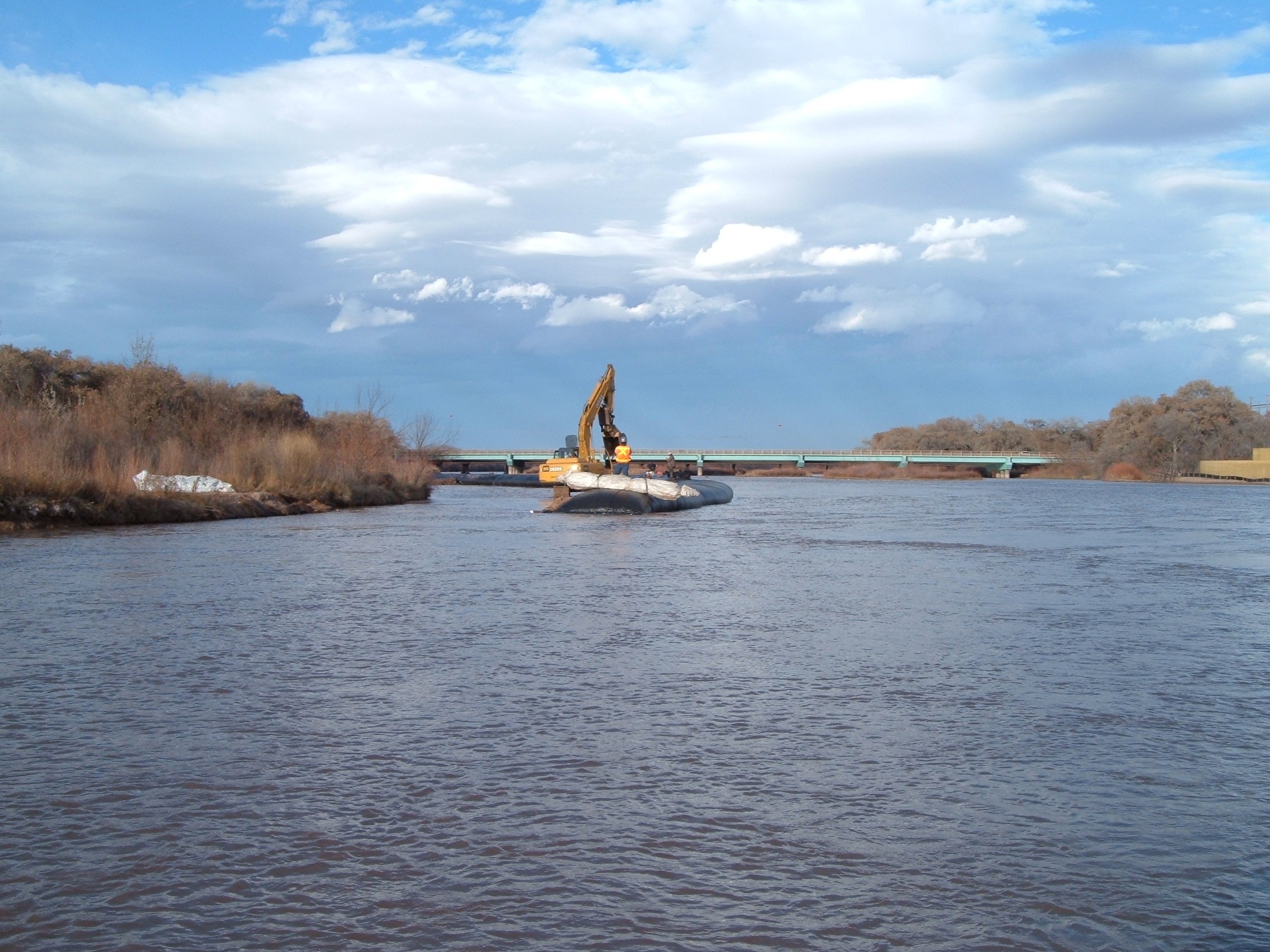
The next AquaDam® has been placed on the closed end of of the last dam by the excavator.

To provide extra support, a berm of fill material was placed on the dewatered side of the AquaDam. It is imperative to ensure the AquaDam® maintains its full height throughout the project's duration, and regular maintenance pumping may be required.
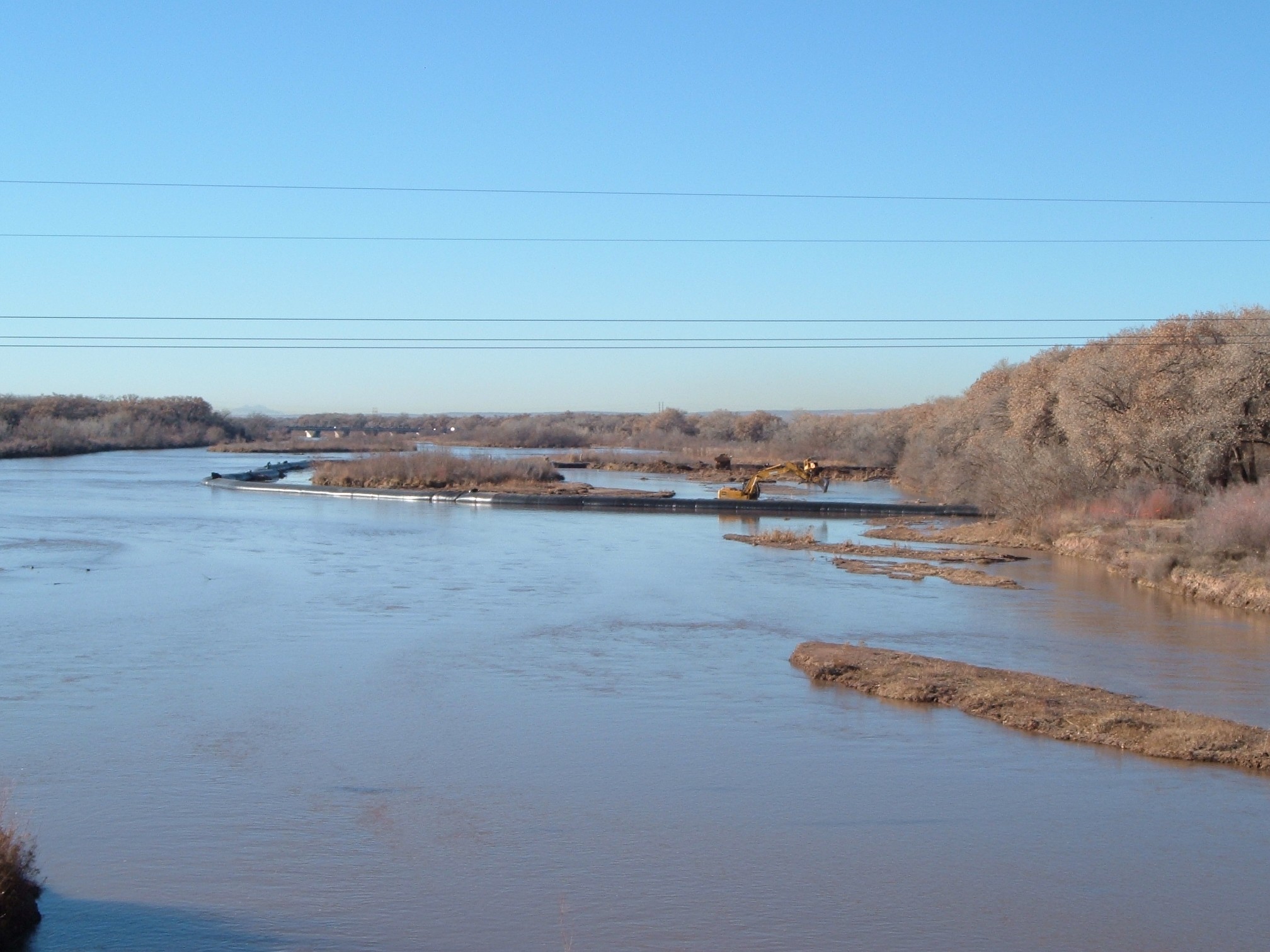
The AquaDam® cofferdam system has successfully redirected the flow of the river away from the construction site. Any water that has accumulated within the work area will be removed through pumping. Once each AquaDam® is filled with water, the fill-tubes will be securely fastened to prevent any leakage.
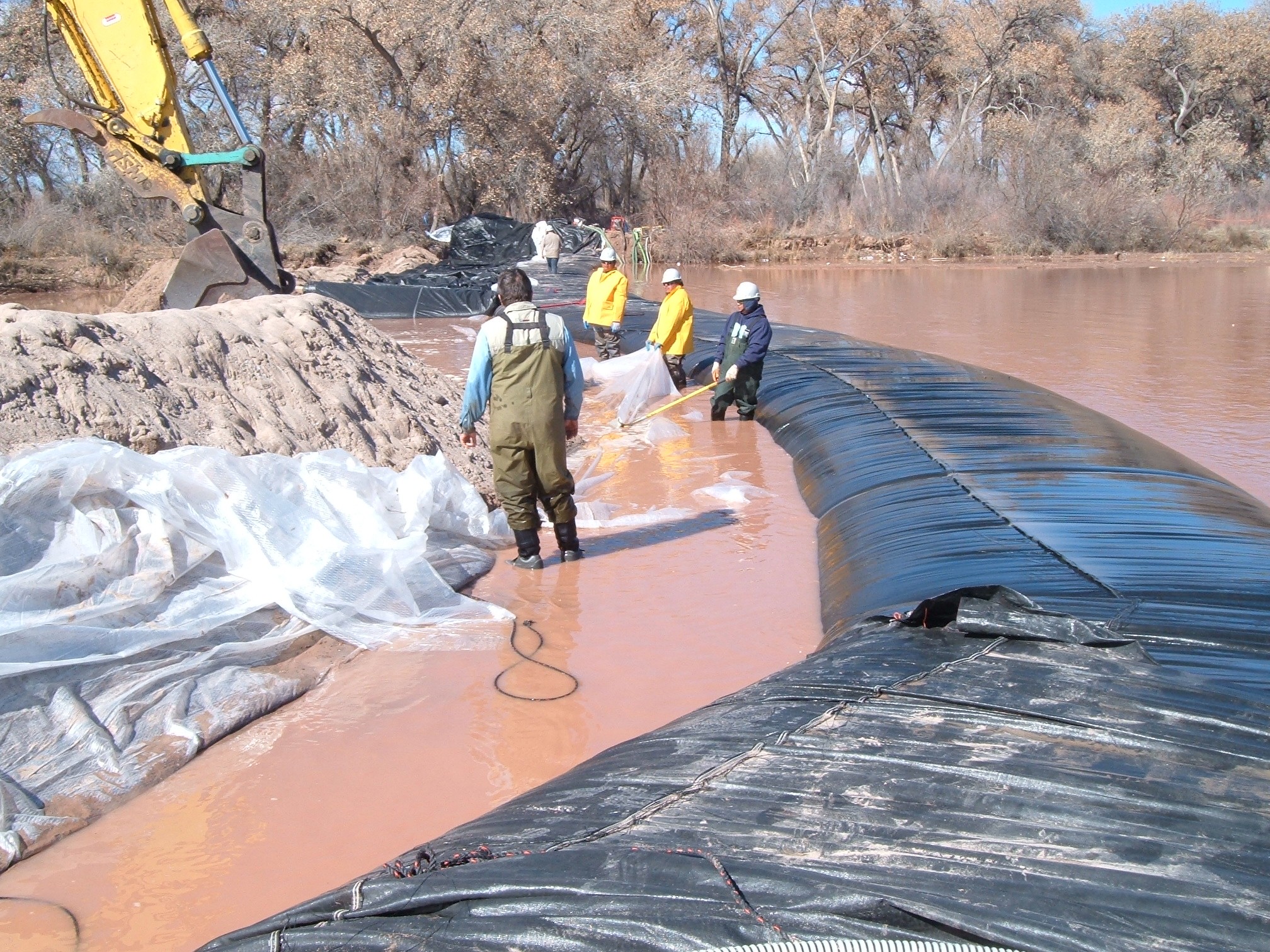
As a result of the heavy rainfall, the water level in the river rose significantly, posing a threat to the integrity of the existing AquaDams. In response, larger AquaDams were promptly installed to replace the smaller ones, ensuring the protection of the work area from potential flooding.
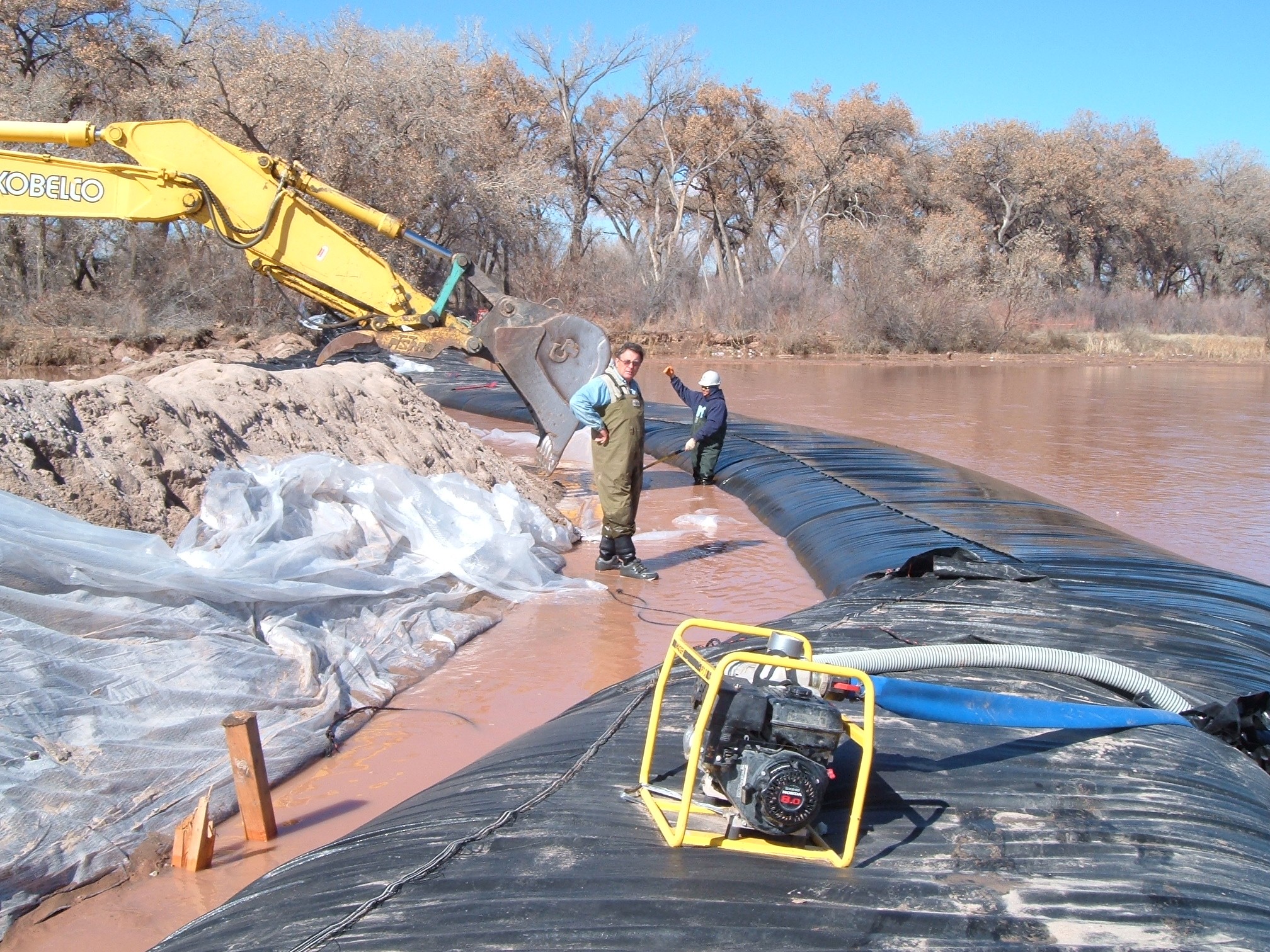
The substantial amount of fill must be relocated in order to facilitate the installation of the larger AquaDams. Check out the water depth where the workers are standing.
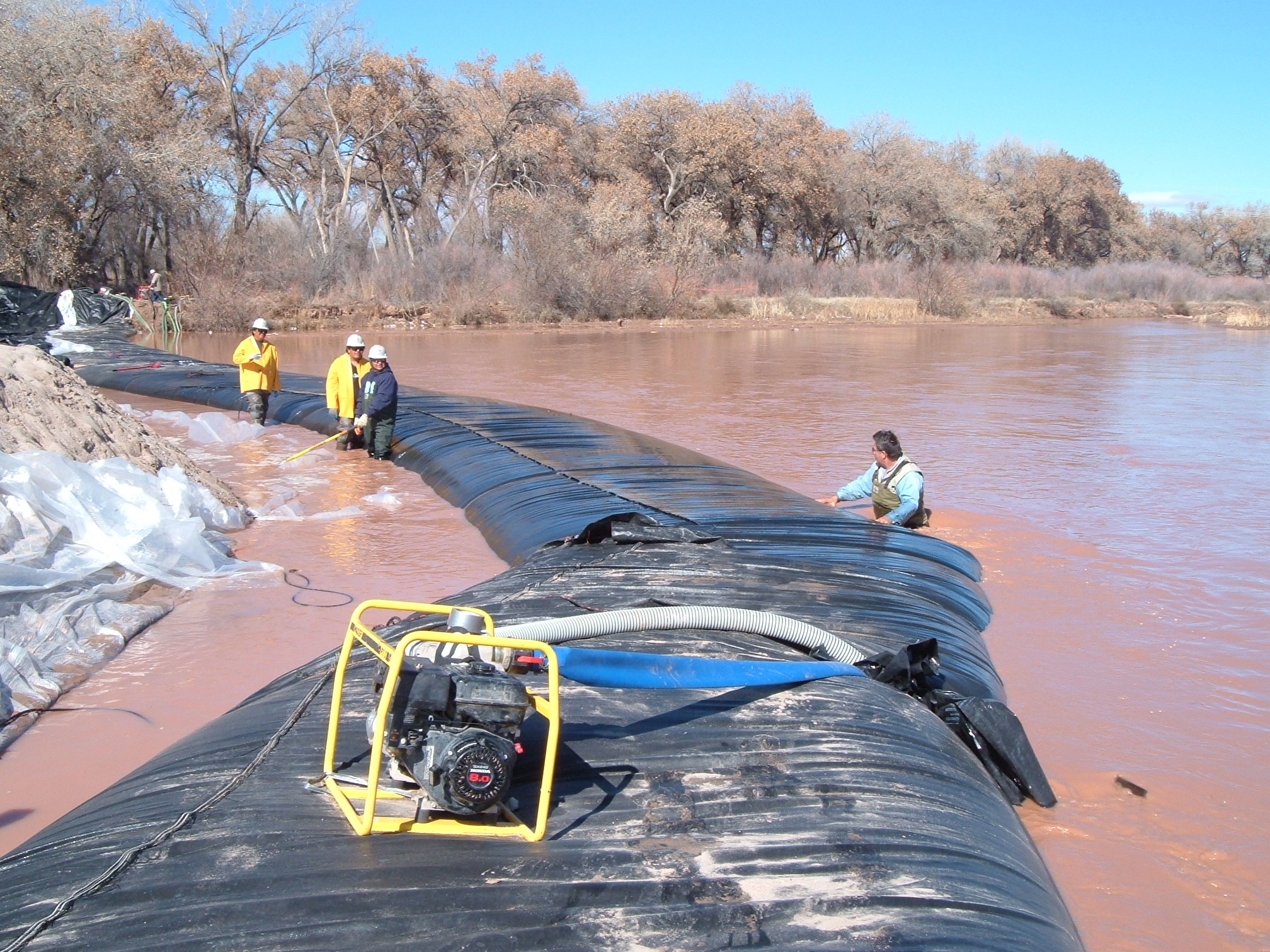
The water depth of the river is almost as high as the already installed AquaDams.
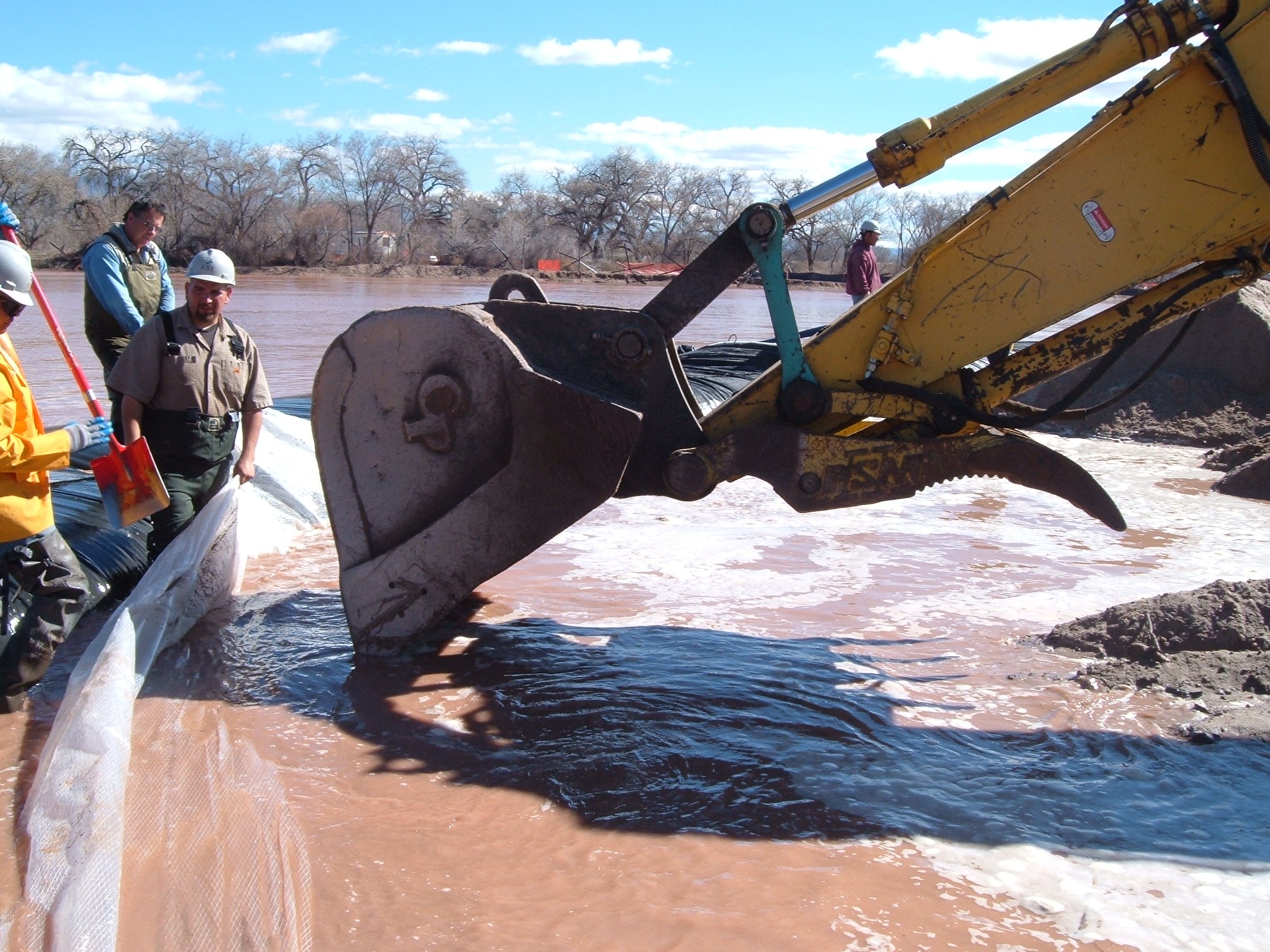
Due to a higher water depth than originally planned, by the contractor, it was determined that fill should be placed behind the AquaDams to provide greater stability against the possibility of increasing water depth.
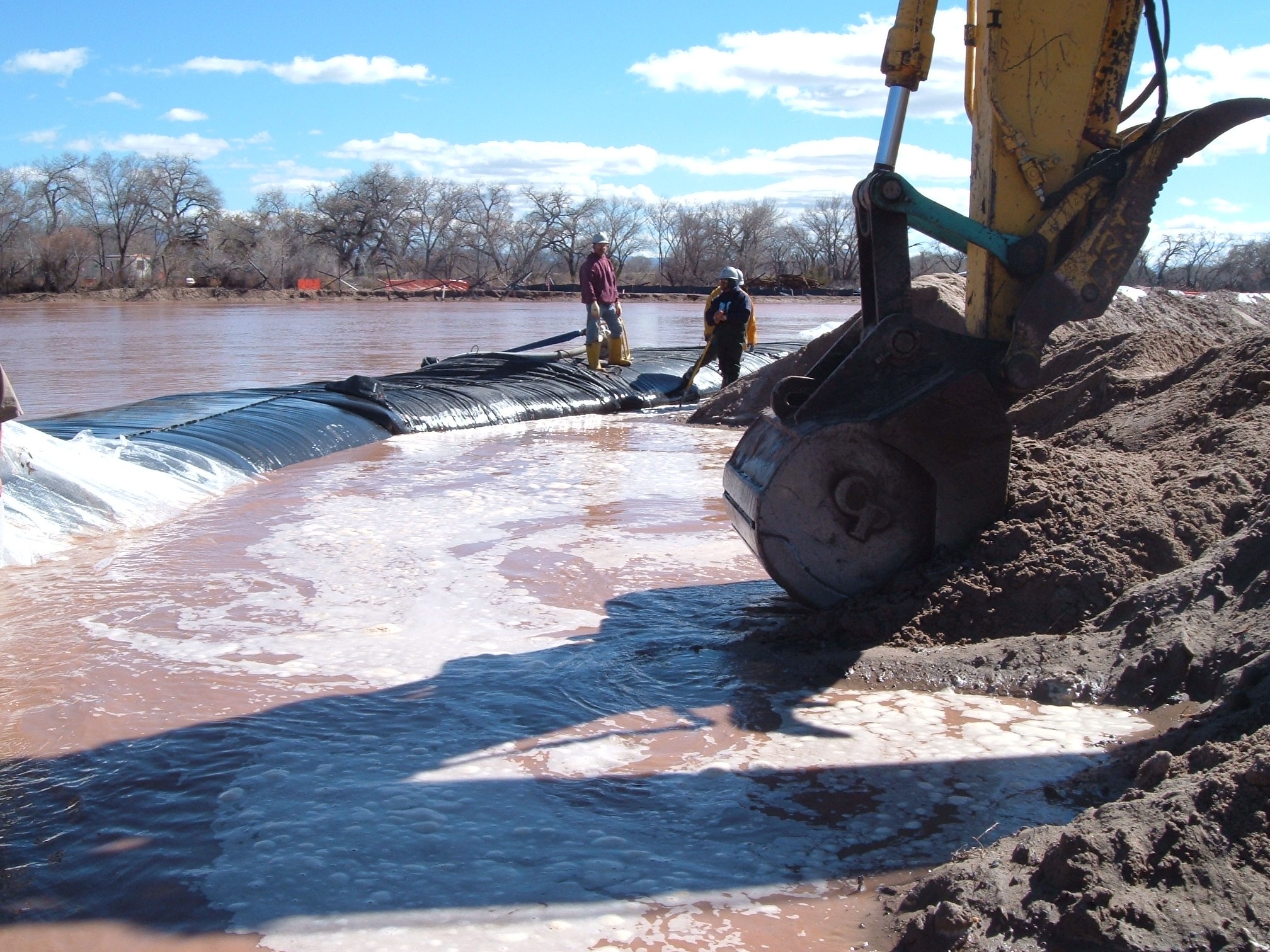
The new AquaDams will be installed in between the old ones and the fill pile being moved.

The excavator continues to move material out of the path, while the AquaDam® is filled with water.
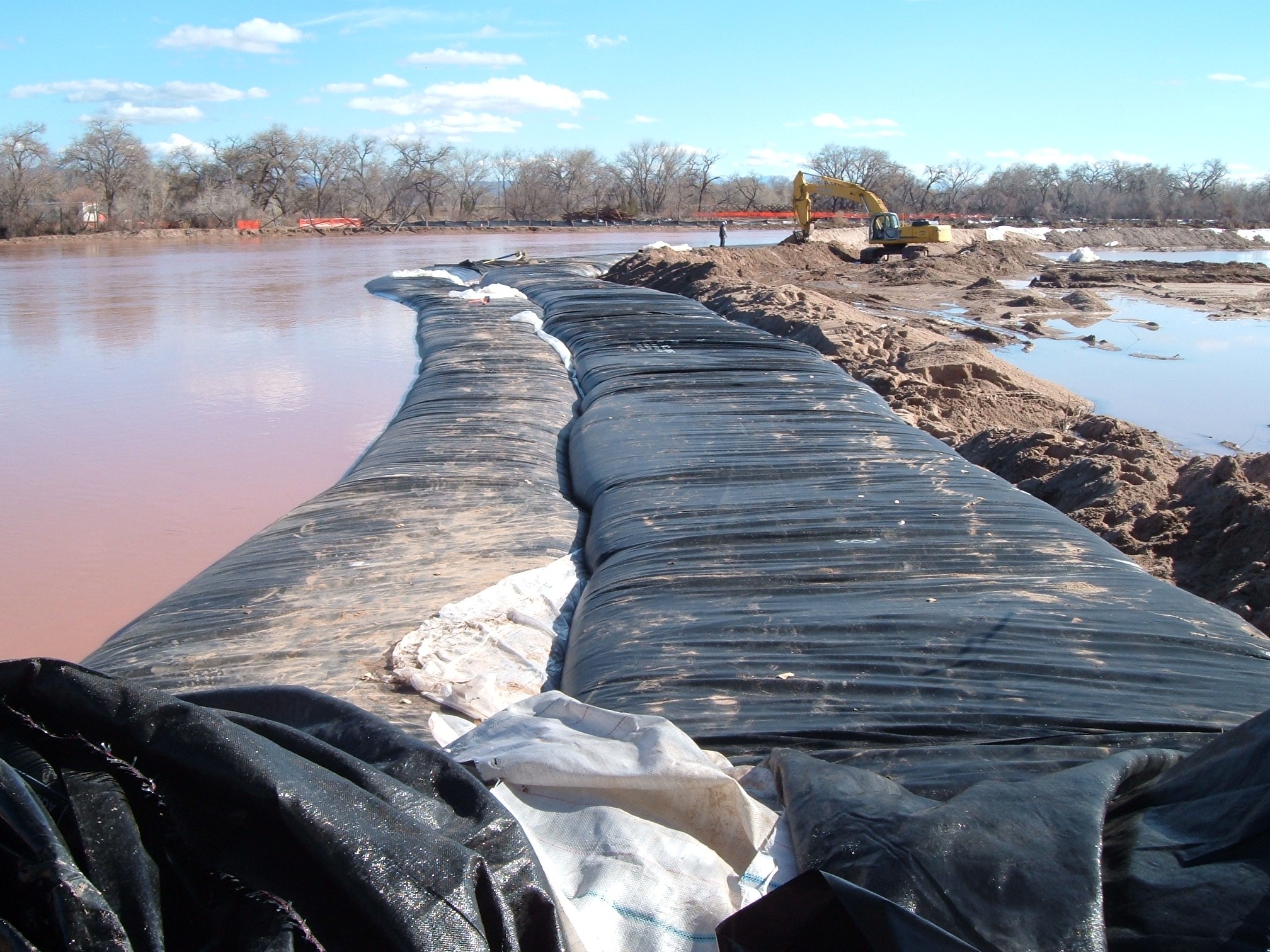
The new set of AquaDams has been squeezed in between the fill and older set of dams, here on the upstream end.
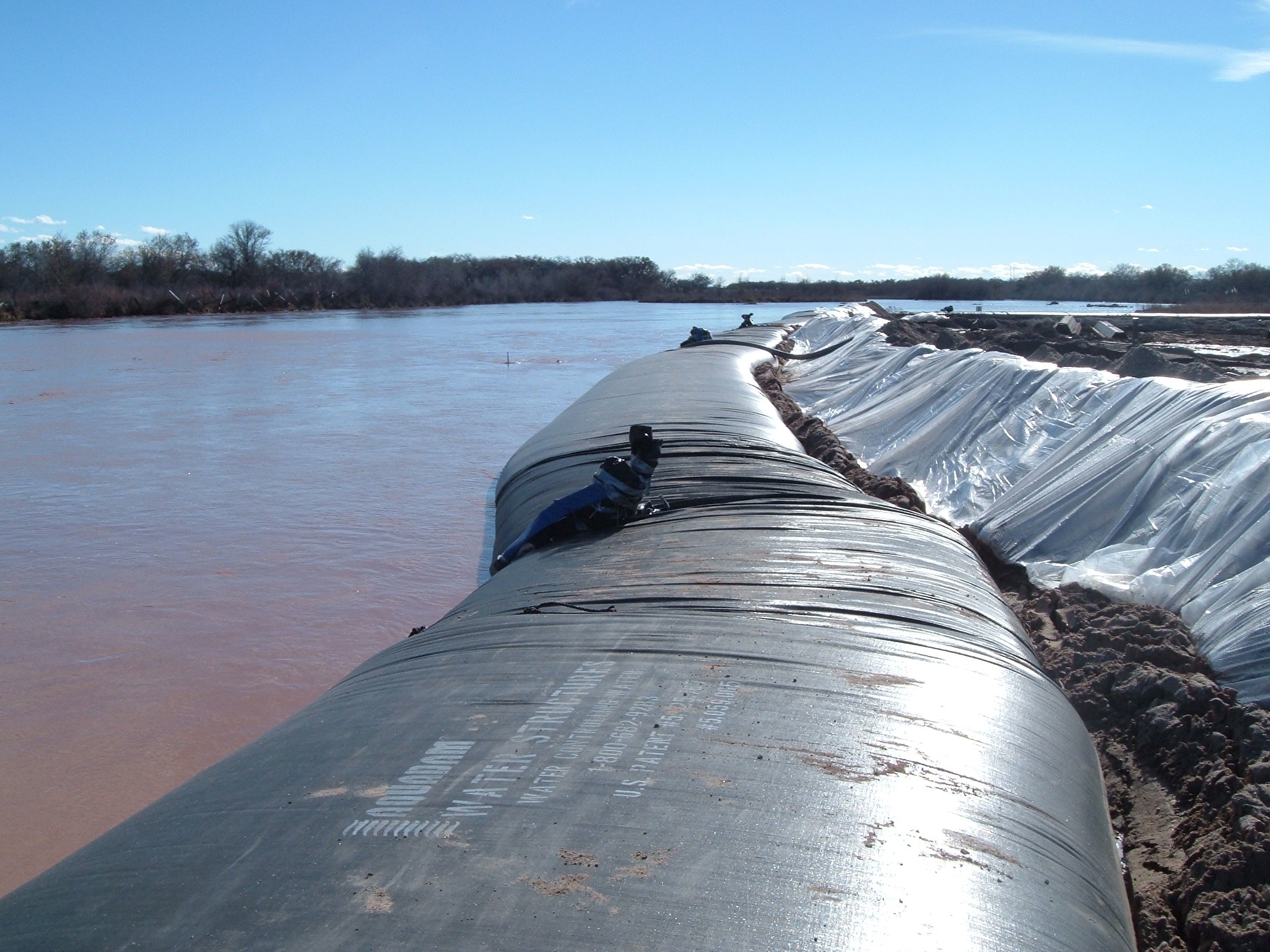
The connection nearest to the camera indicates that the riverbed has likely eroded on the left side, causing the AquaDam® to lean towards the center of the river.
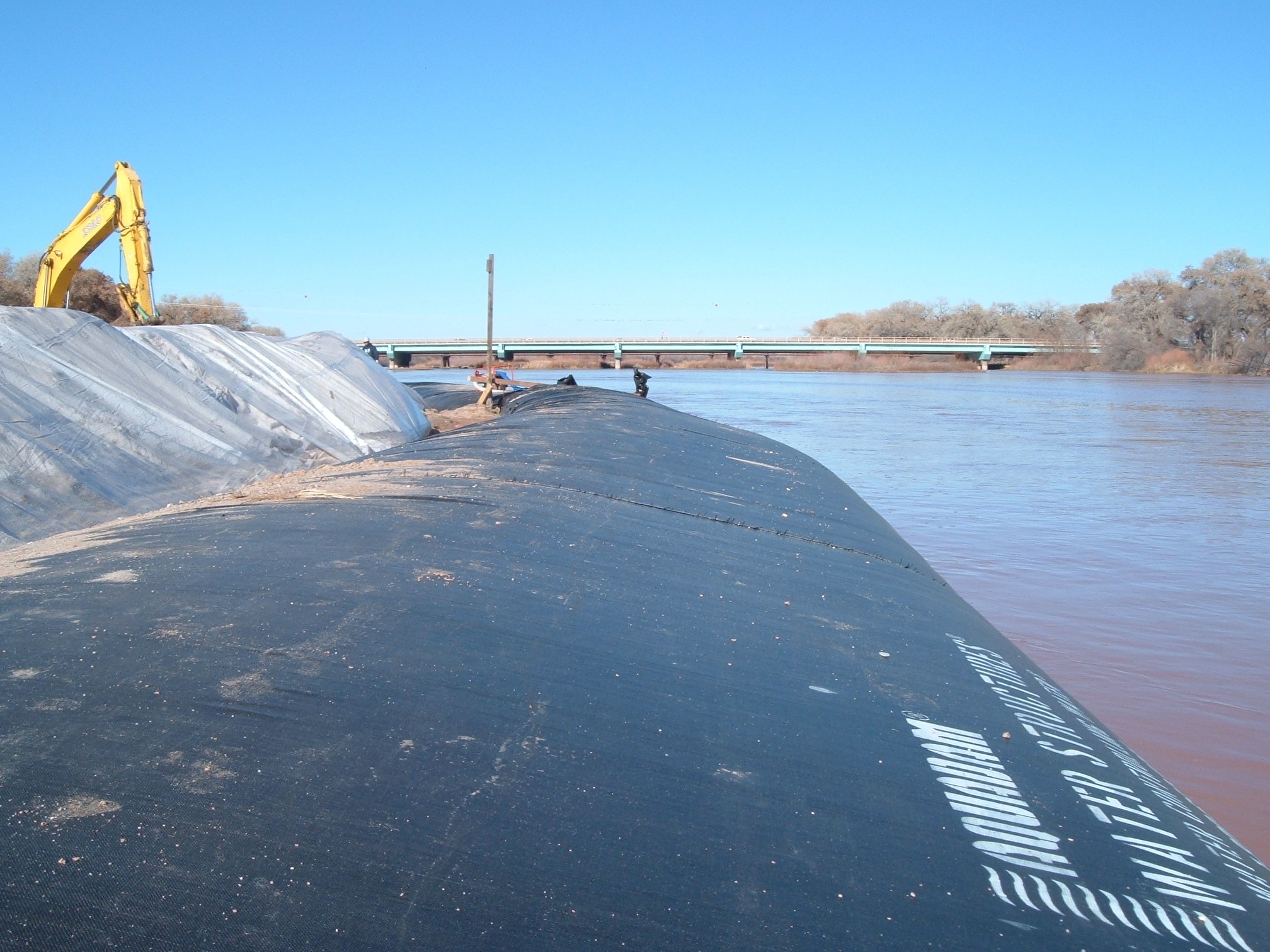
Looking upstream, now the lean can be seen towards the right.

The first new AquaDam® has been successfully unrolled and is currently being filled. Workers are now in the process of preparing to connect and fill the next AquaDam.
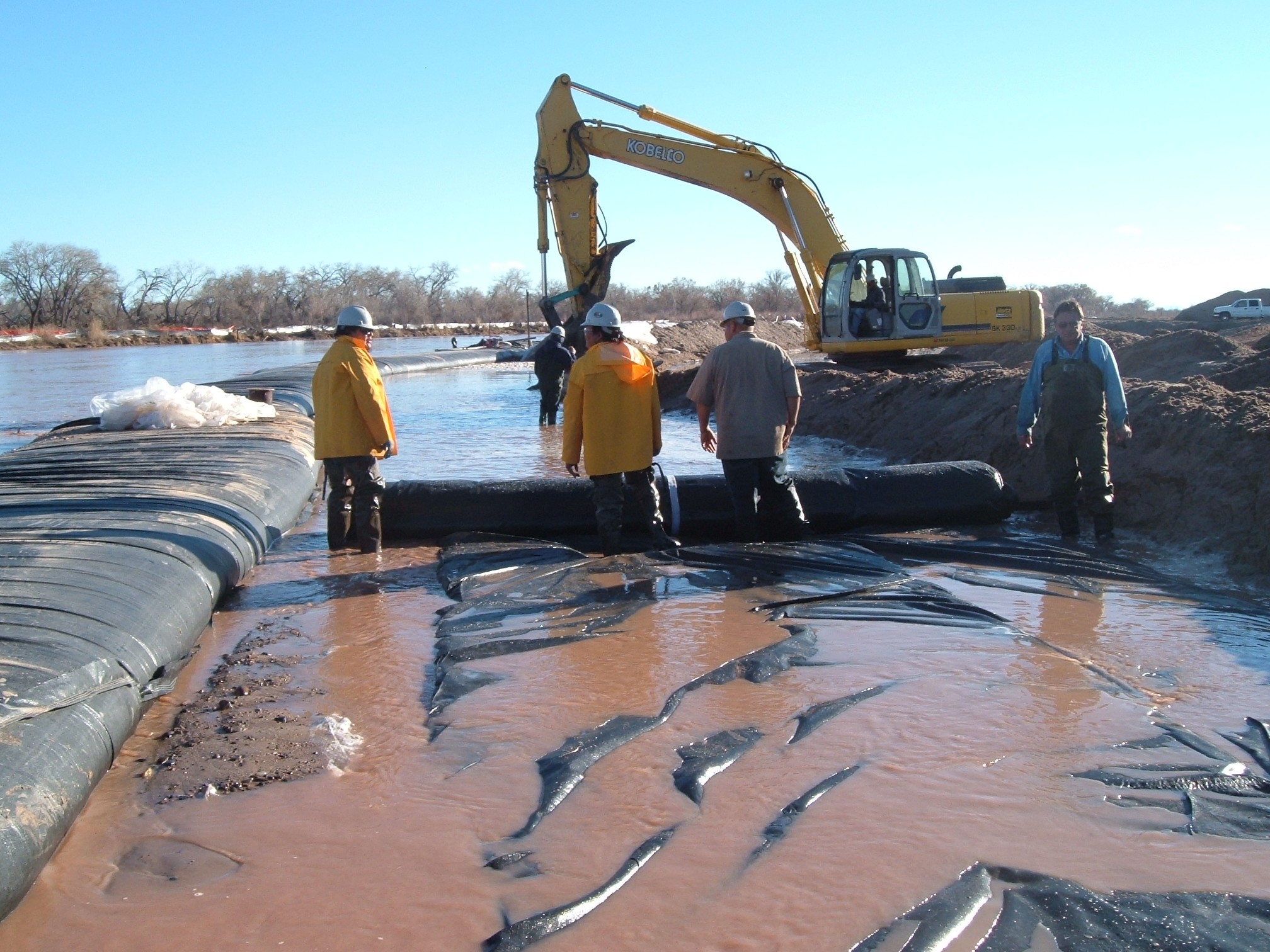
The second new AquaDam® is being unrolled where it will be filled up with the river’s water.
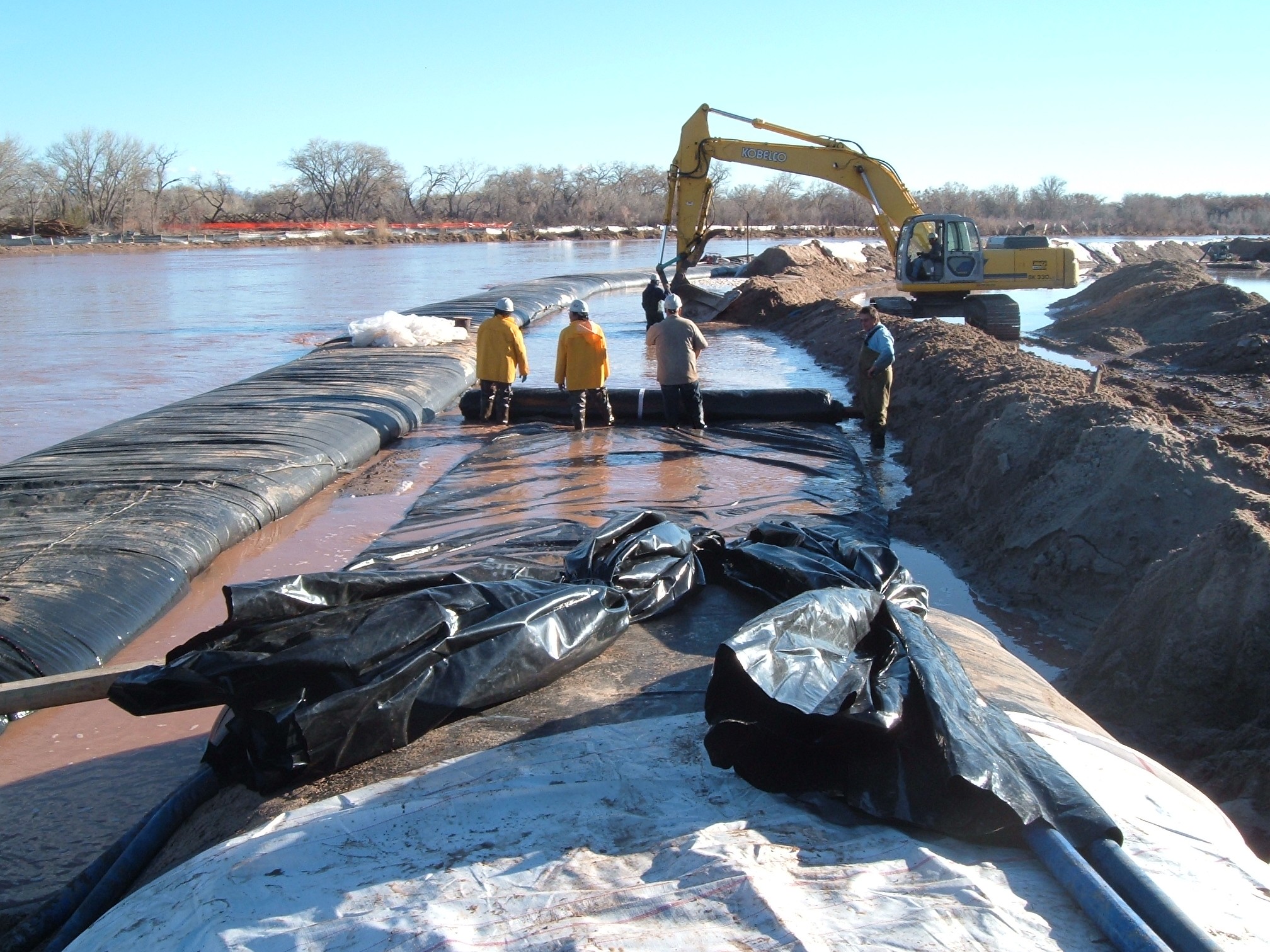
The second new AquaDam® is filling with water. The closed end of the first new AquaDam® acts as the starting bank for the second one.

Workers continue to unroll the AquaDam® into place as it is filled with water.
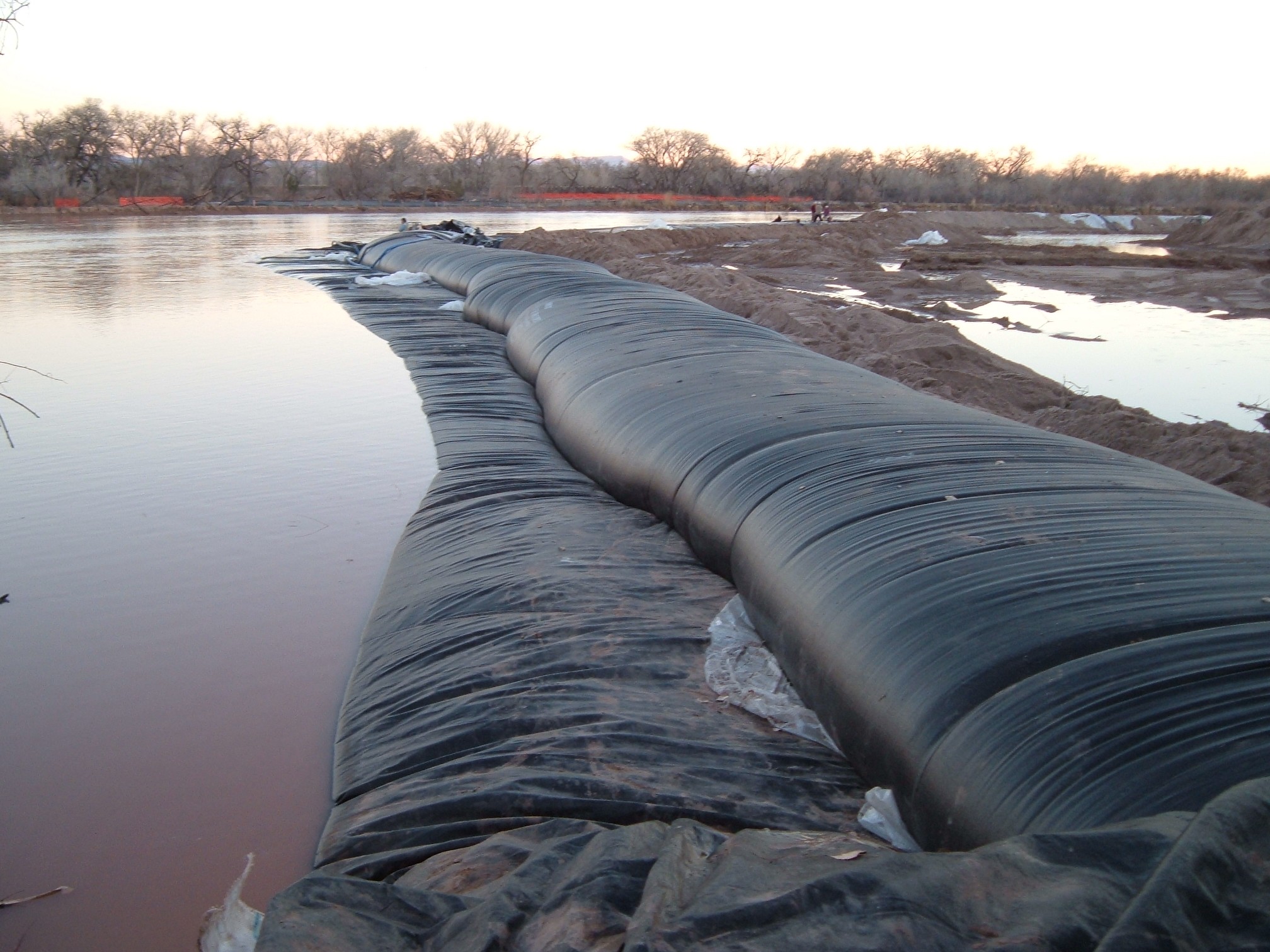
The first new AquaDam® is pretty much full of water now.
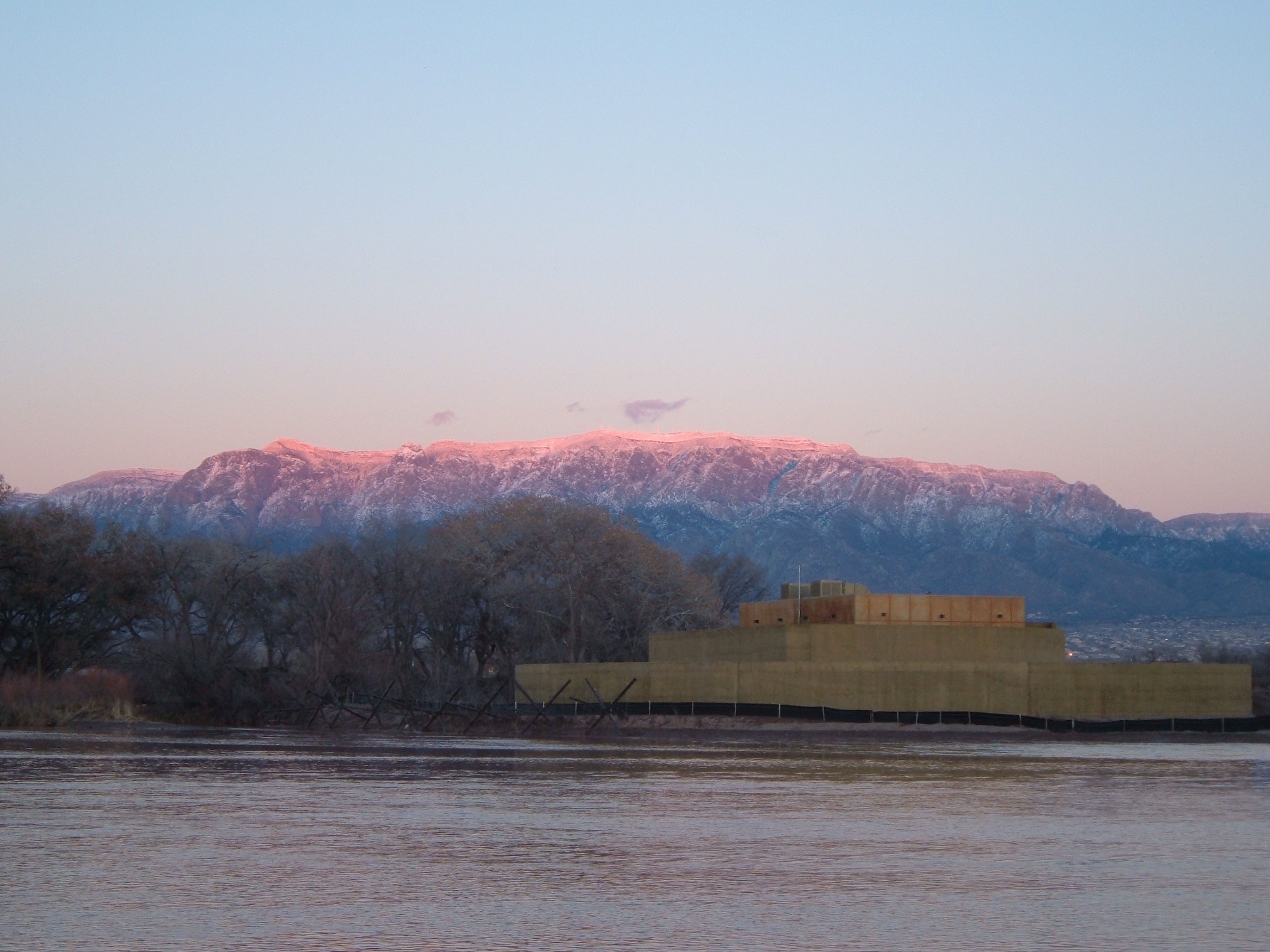
Part of the new water diversion/intake structure for Albuquerque Bernalillo County Water Utility Authority.
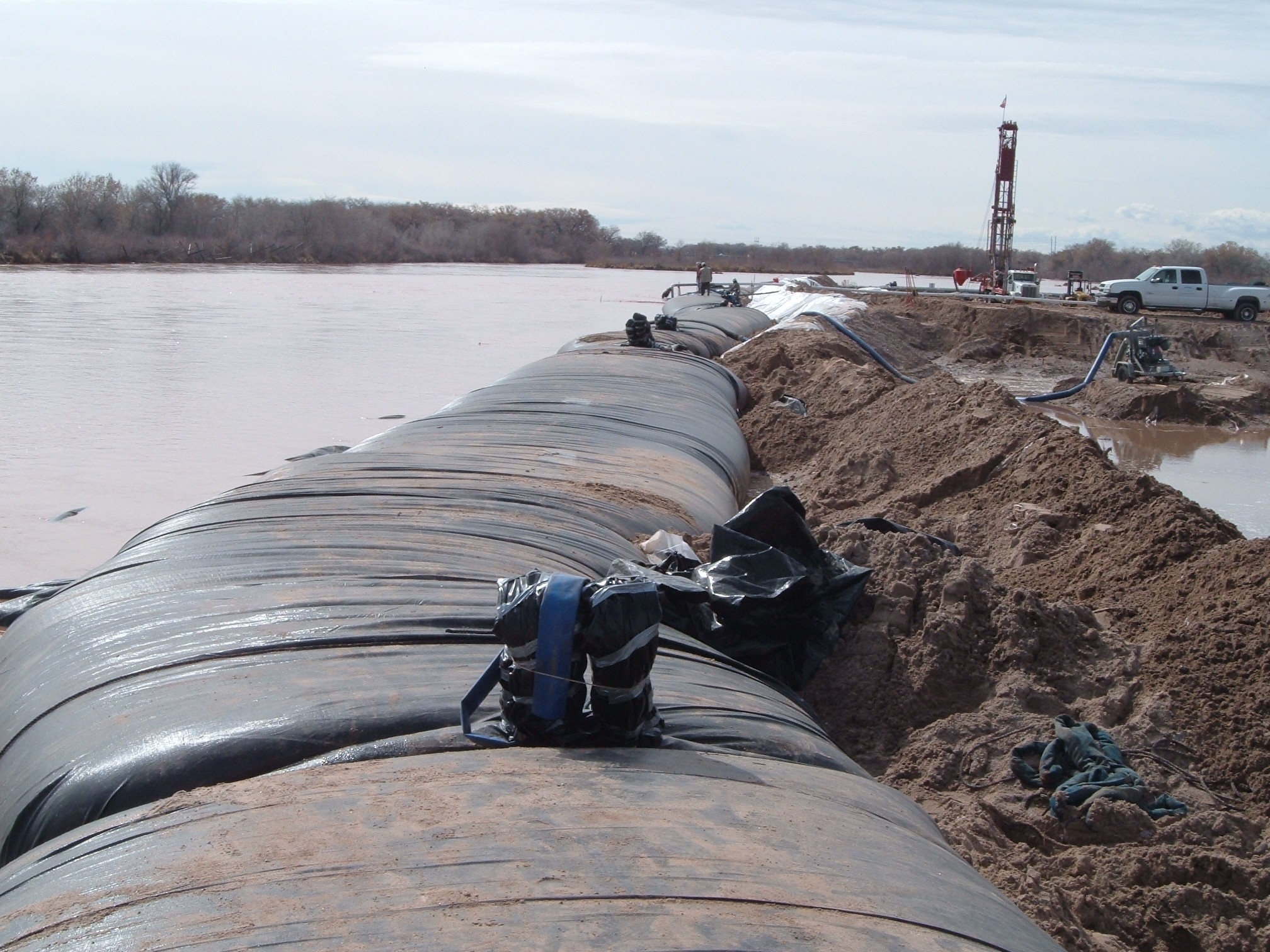
The new set downstream AquaDams has been installed pretty much over the top of the old ones.

Large piles of fill have been laid to help support the AquaDam® cofferdam system.
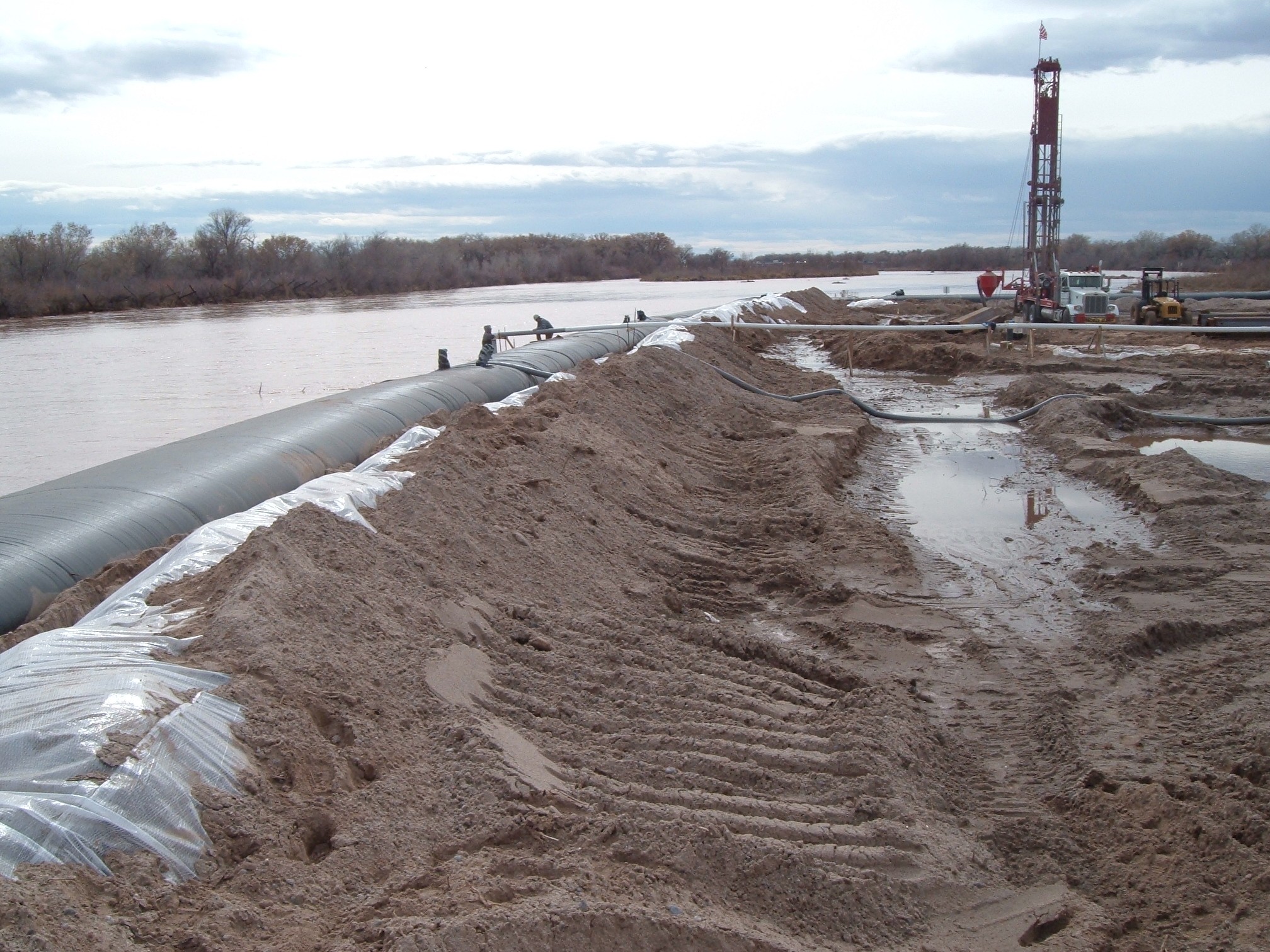
A view looking downstream from inside the work area.
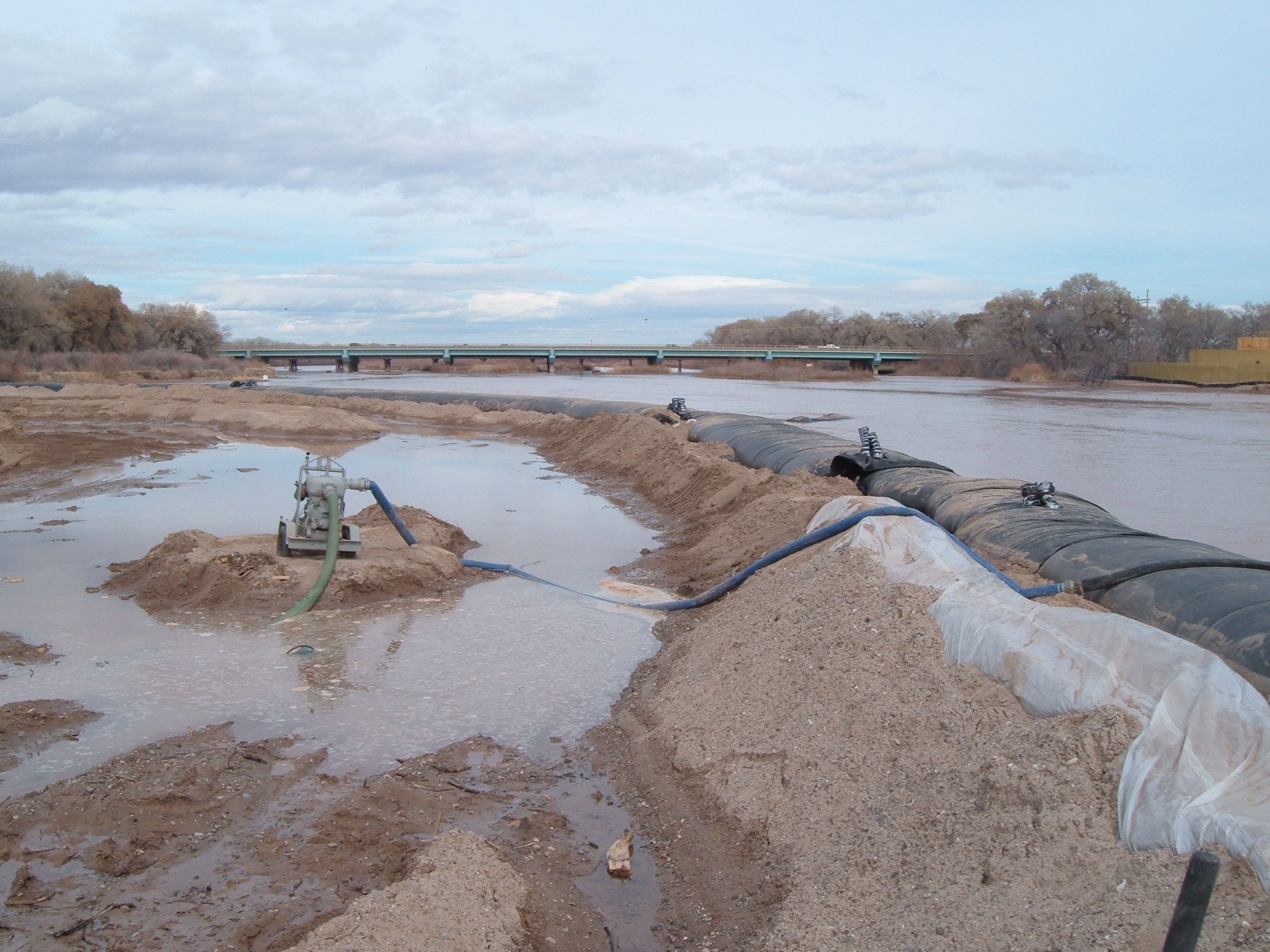
A view looking upstream from inside the work area.
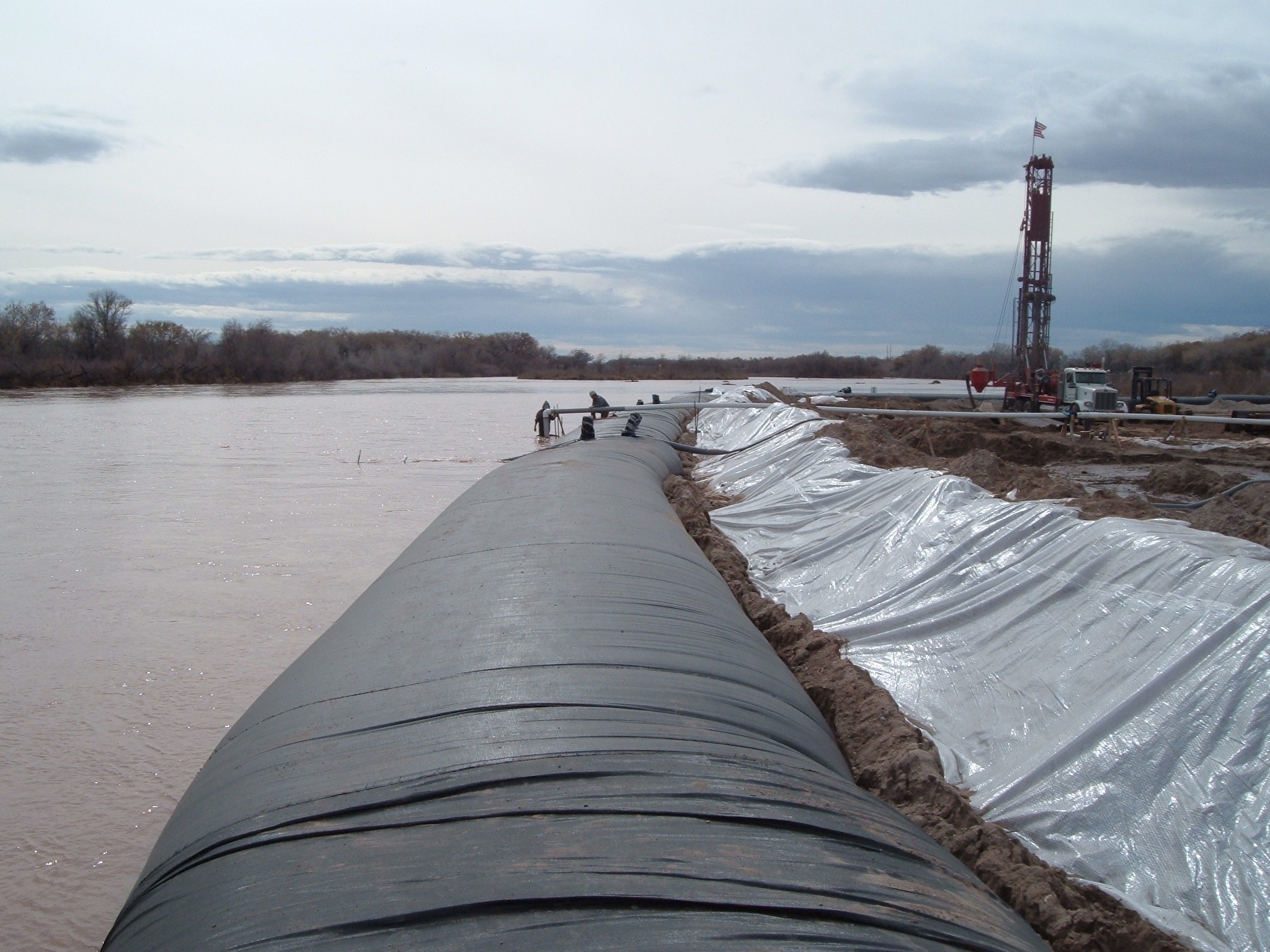
The latest AquaDams have been successfully installed and are effectively redirecting the flow of the river away from the construction site. The AquaDam® cofferdam system has been installed in a horseshoe or “U” shape configuration to isolate the work area.
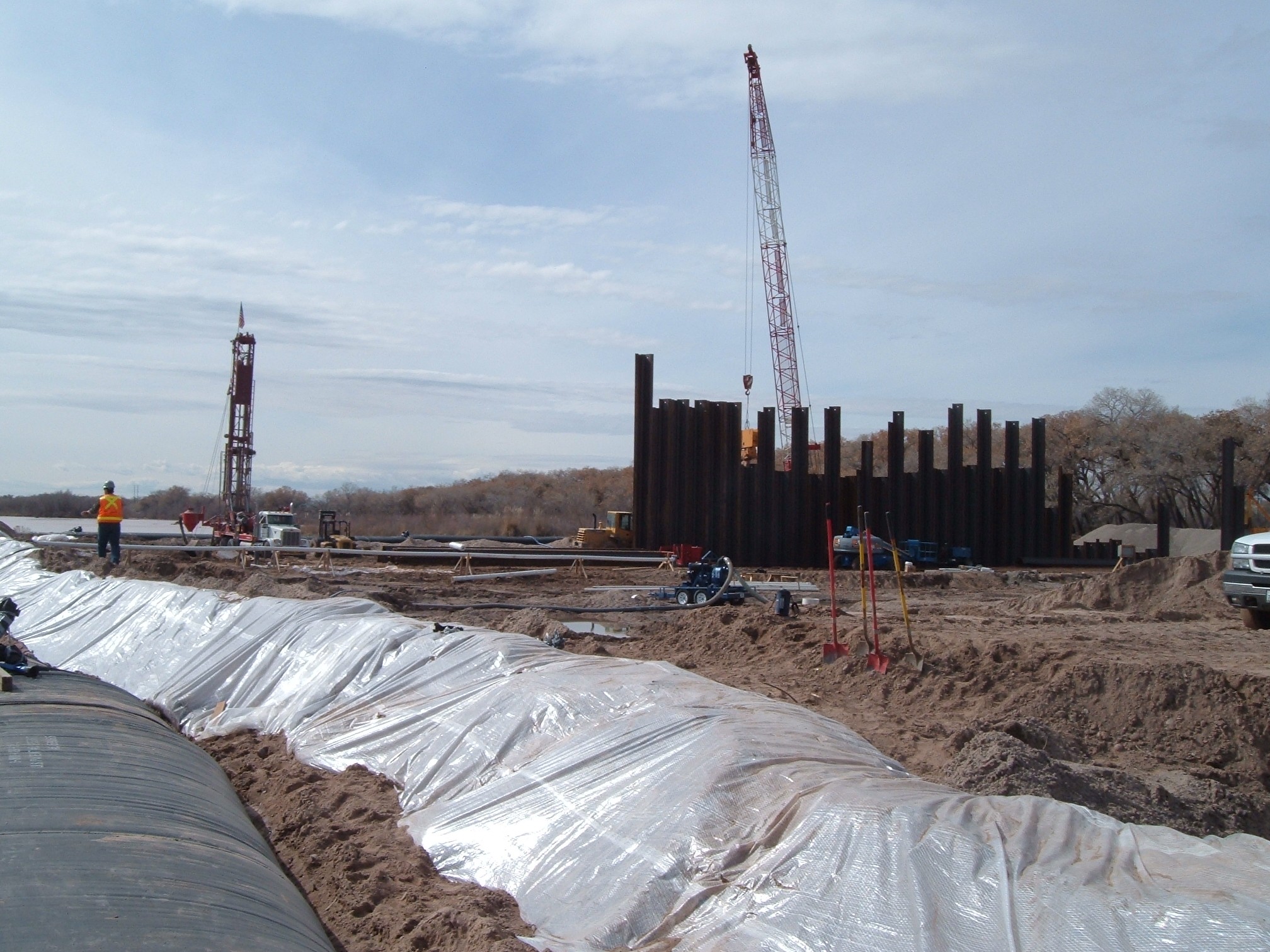
The sheet piling serves as the foundation for the concrete pad that is to be poured. The steel beams, measuring approximately 40 feet in length, will be securely driven into the ground, resembling stakes.
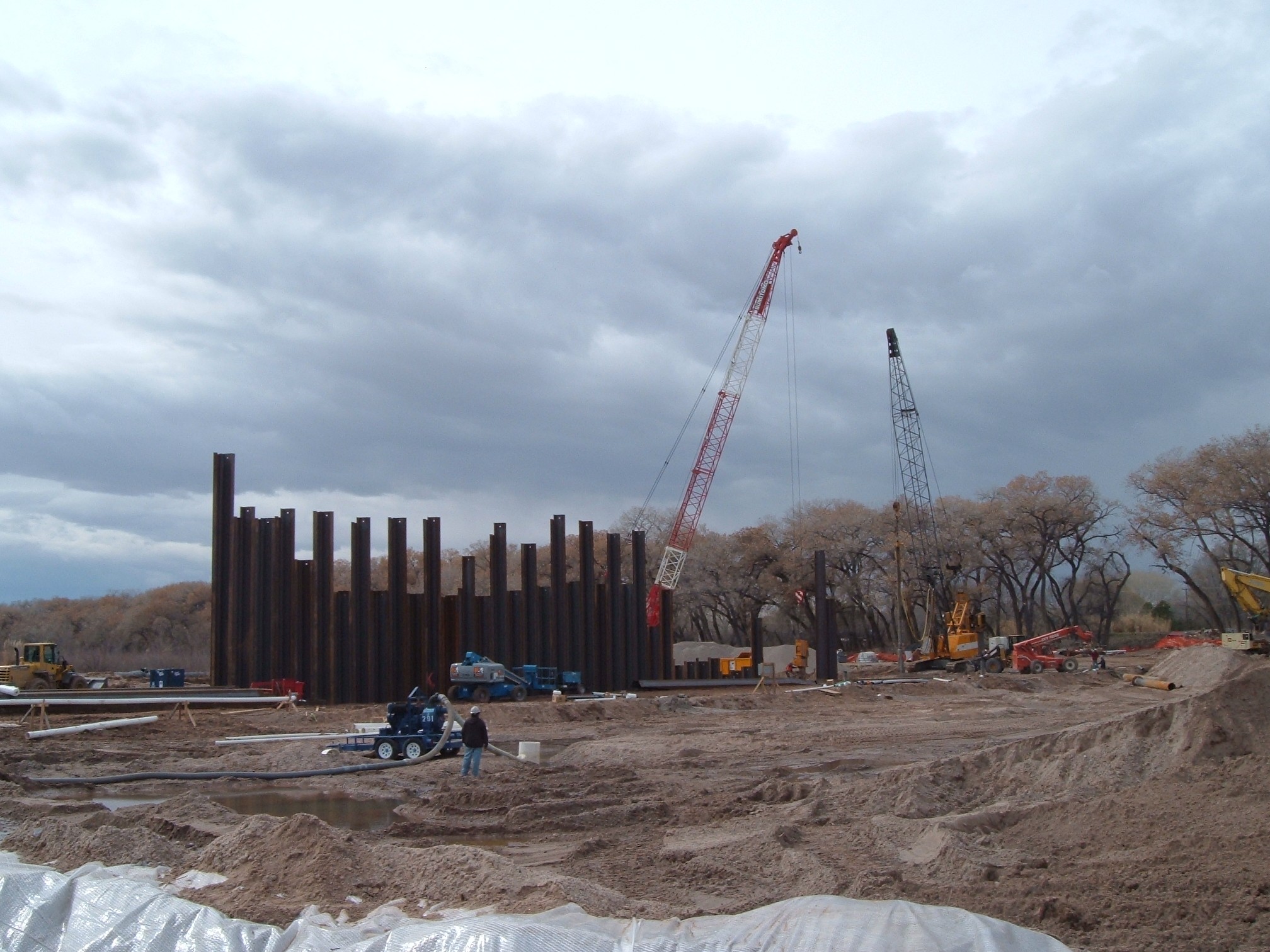
Multiple feet of steel piling were utilized for this project.
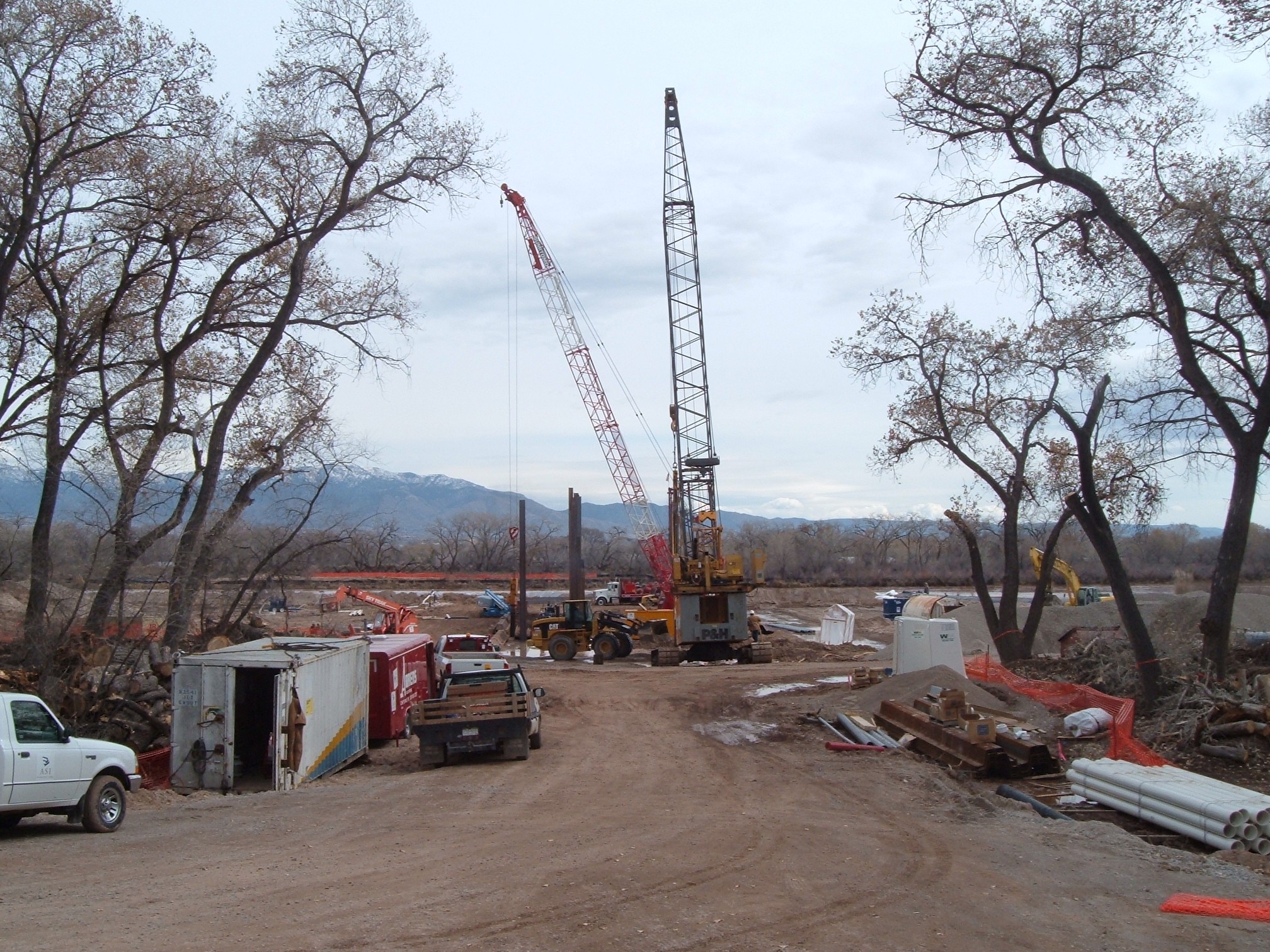
Here we can see some of the construction equipment used to drive the sheet pile into the riverbed.
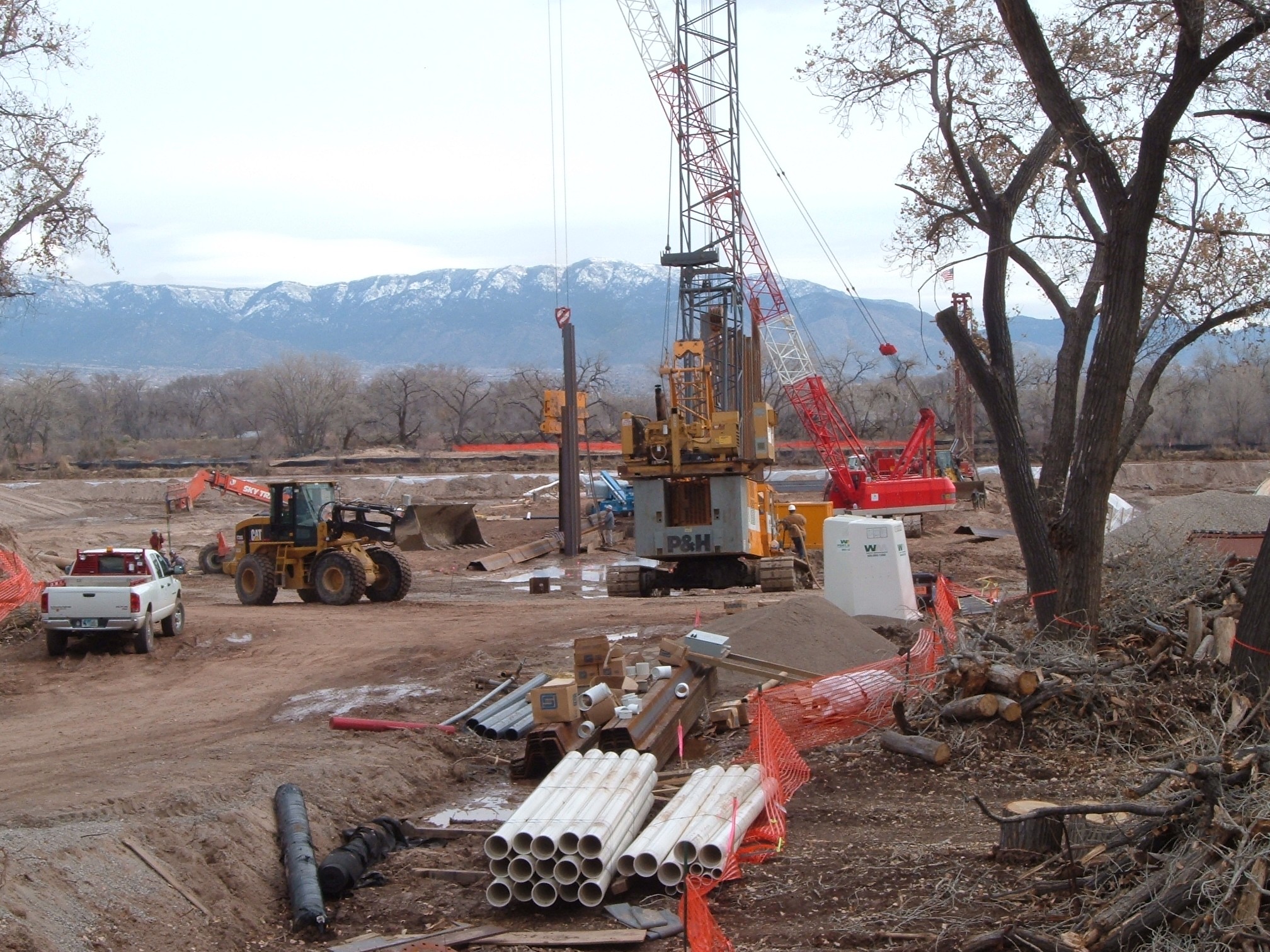
A closer view of the construction area where the pile was driven. You can almost see the entire work area on just this one photo.
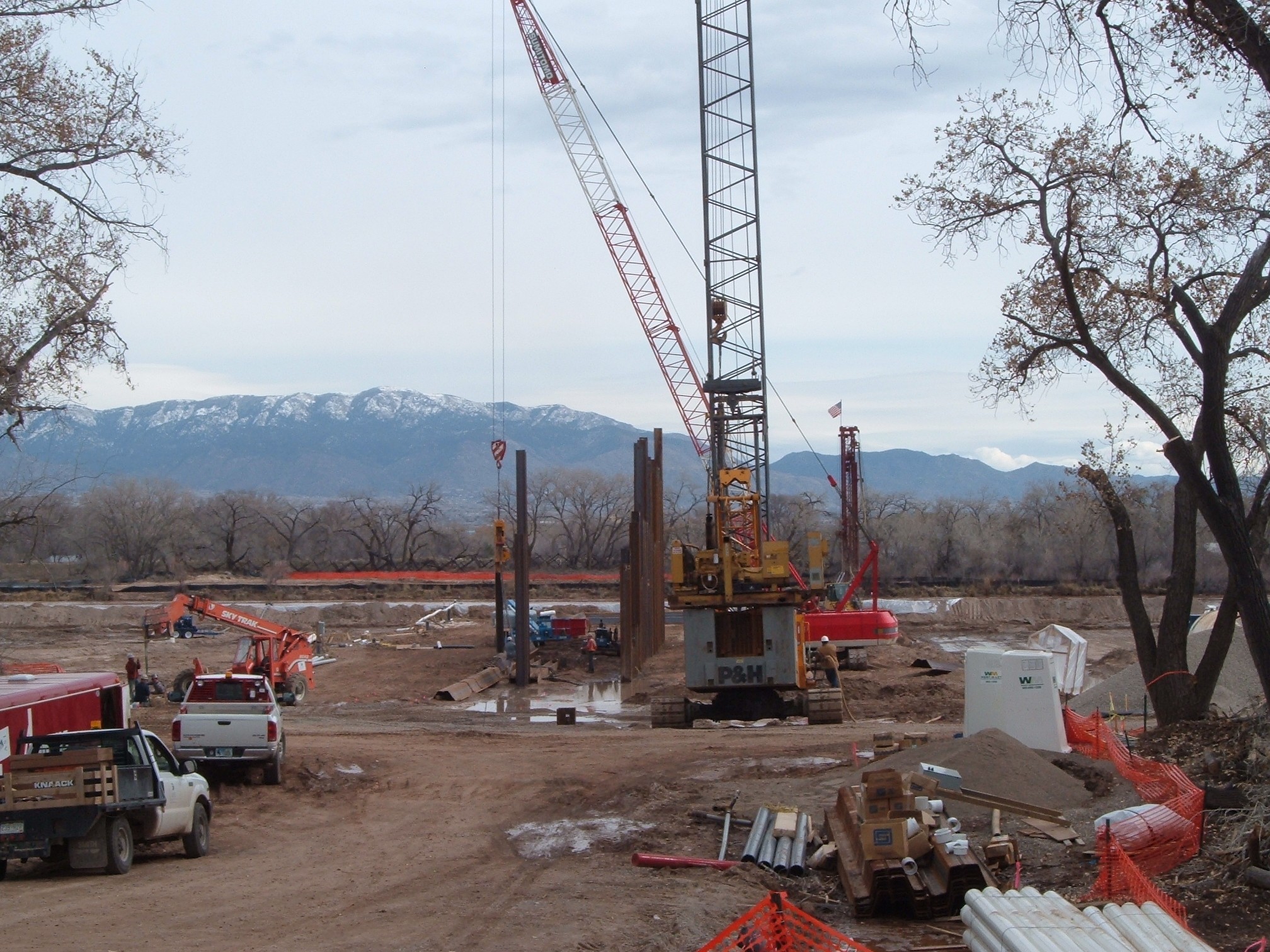
Workers wasted no time getting the job done while the river was being diverted.
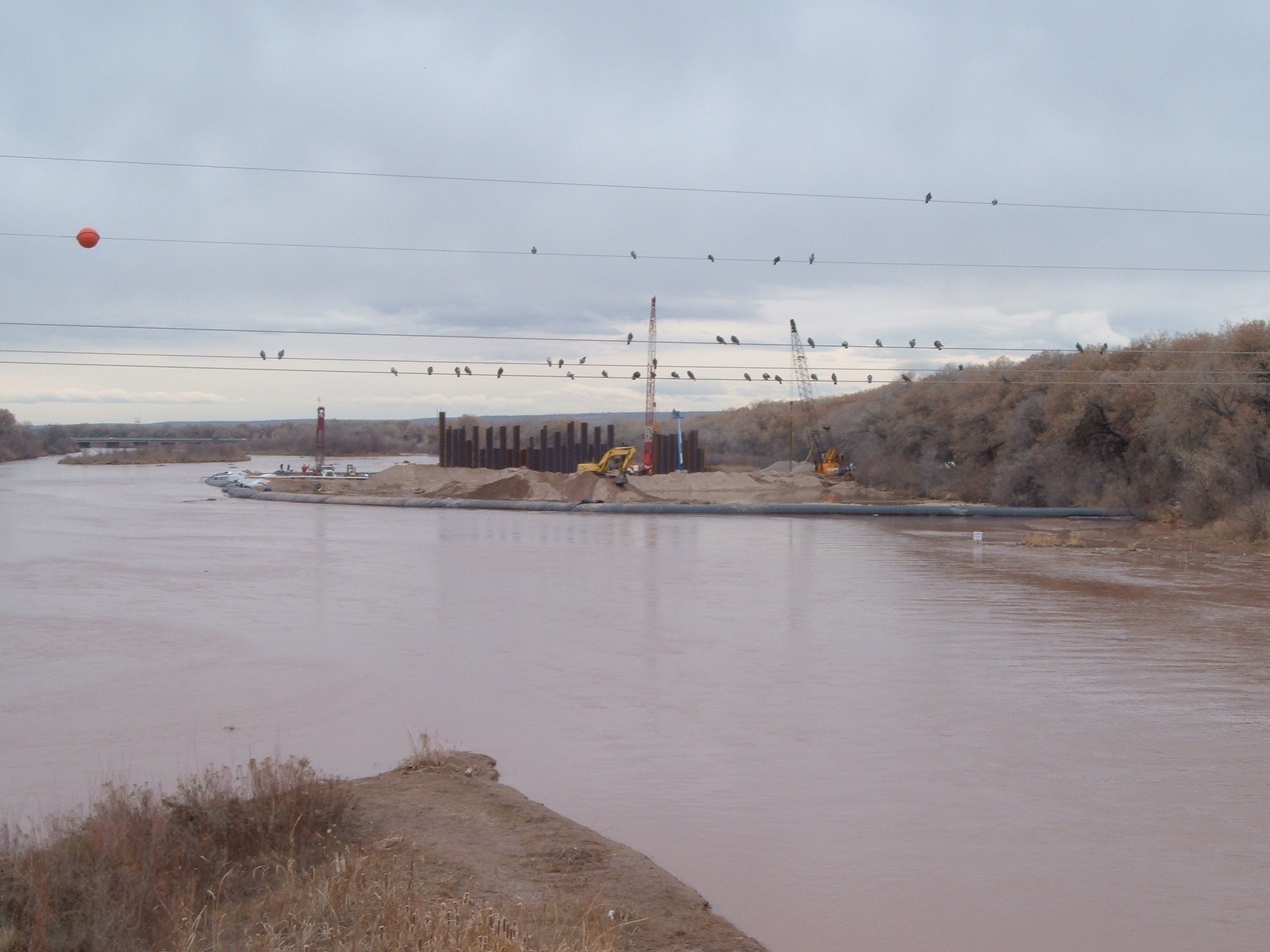
A photo showcasing the AquaDams in operation, taken from a vantage point near the Alameda Boulevard NW Bridge, located just upstream of the project site.
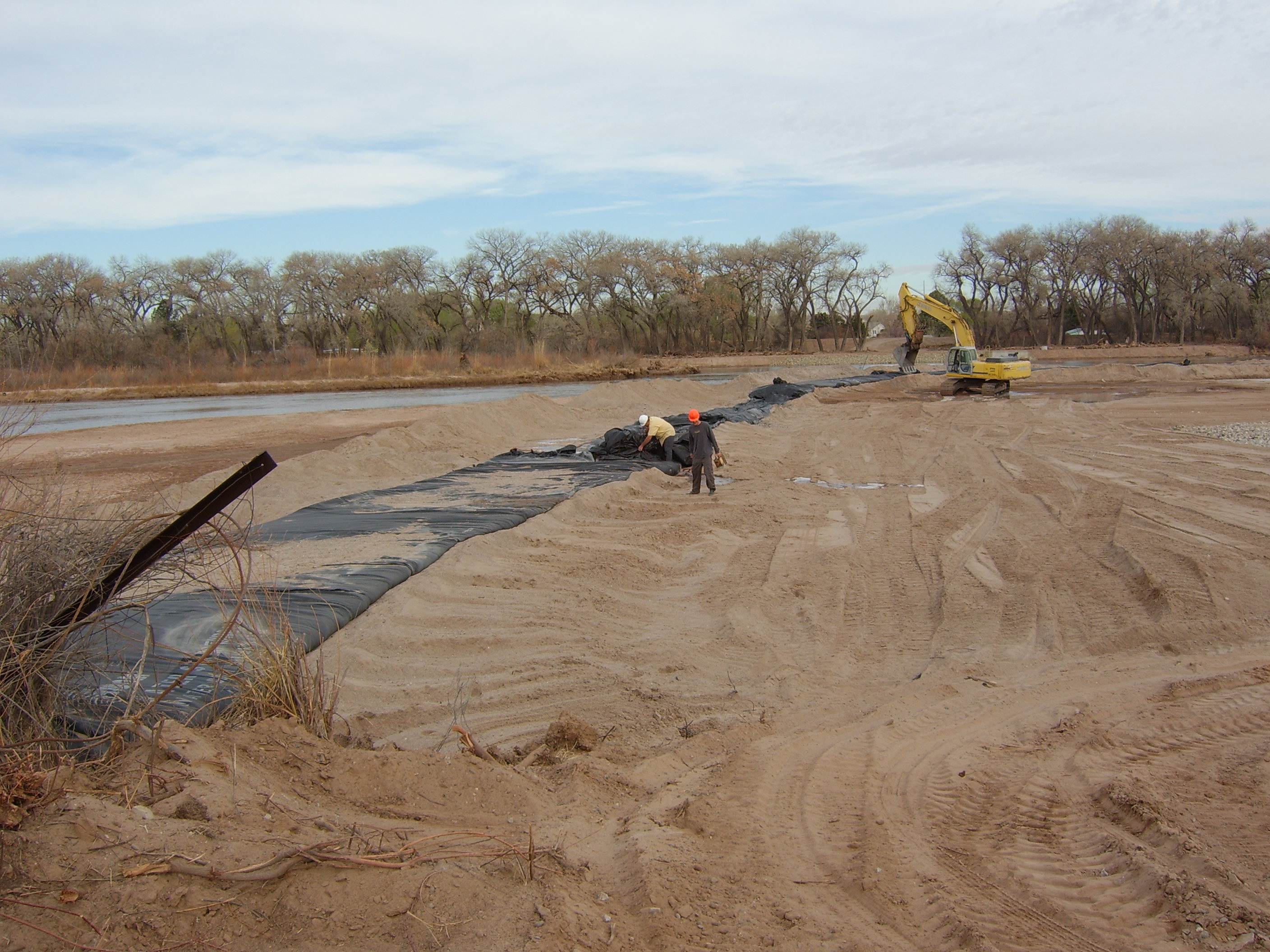
The intake/diversion facility has been successfully constructed, and the next step is to remove the AquaDams. Typically, it is recommended to re-water the work area before removing an AquaDam. In this instance, workers efficiently lowered the first AquaDam® using pumps to decrease the water level in the fill-tubes. By lowering the opening of the fill-tubes, the water is able to drain out effectively.
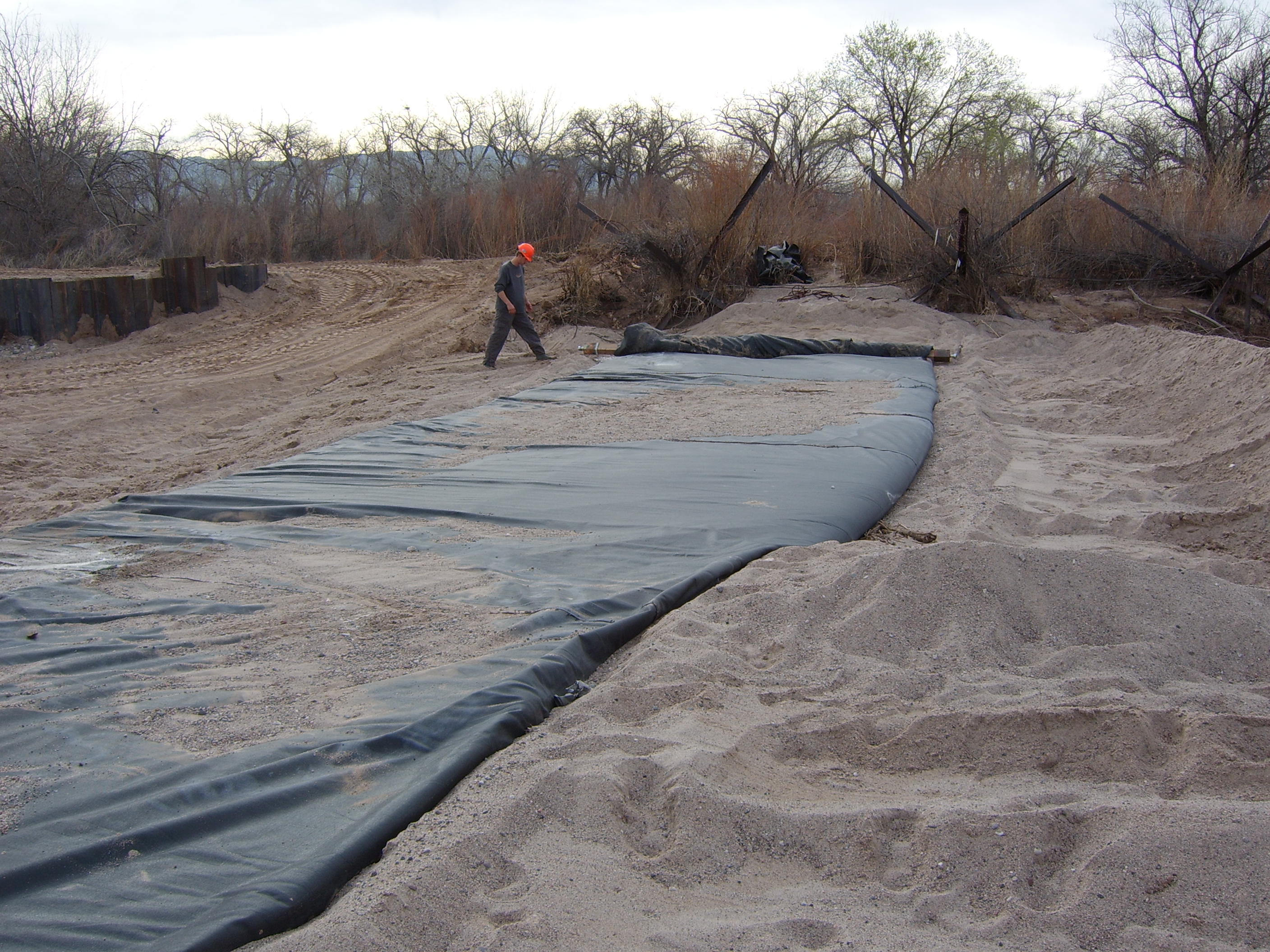
Once the AquaDam® has drained enough water out, workers attached a wooden beam at the closed end and began to re-roll the dam. The re-rolling action helps force the water out of the opening of the fill-tubes.
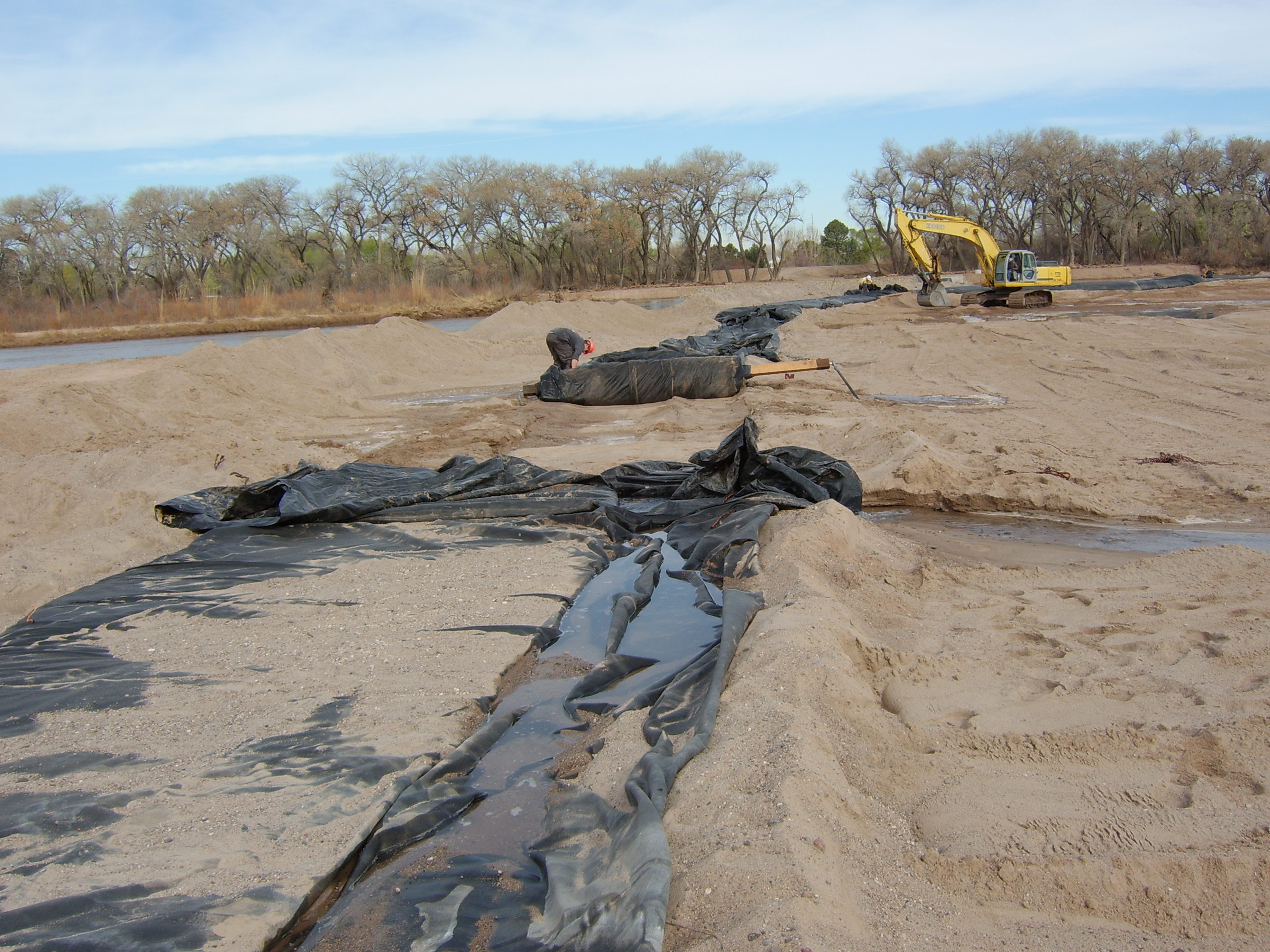
The use of ratchets and specialized brackets greatly facilitates the re-rolling process of the AquaDam. As the AquaDam® is being re-rolled onto the beam, most of the water is drained out of the fill-tubes and workers fold the sides to decrease the width of the roll.

Workers used the excavator to lift and pull the AquaDams, which helped drain out most of the water trapped inside.
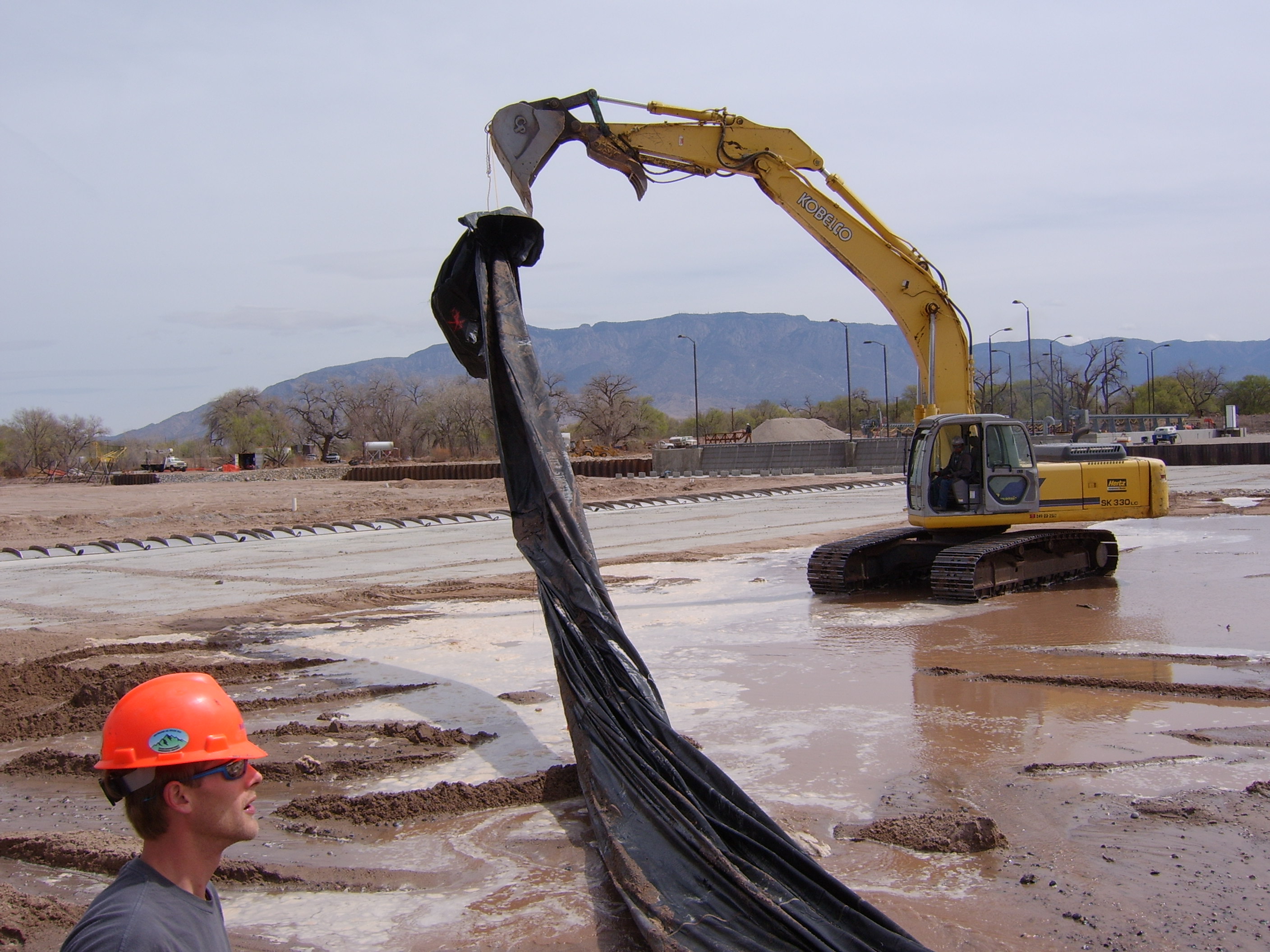
The AquaDams were relocated to a spacious and even terrain for repositioning. The background showcases components of the newly constructed intake/diversion facility.
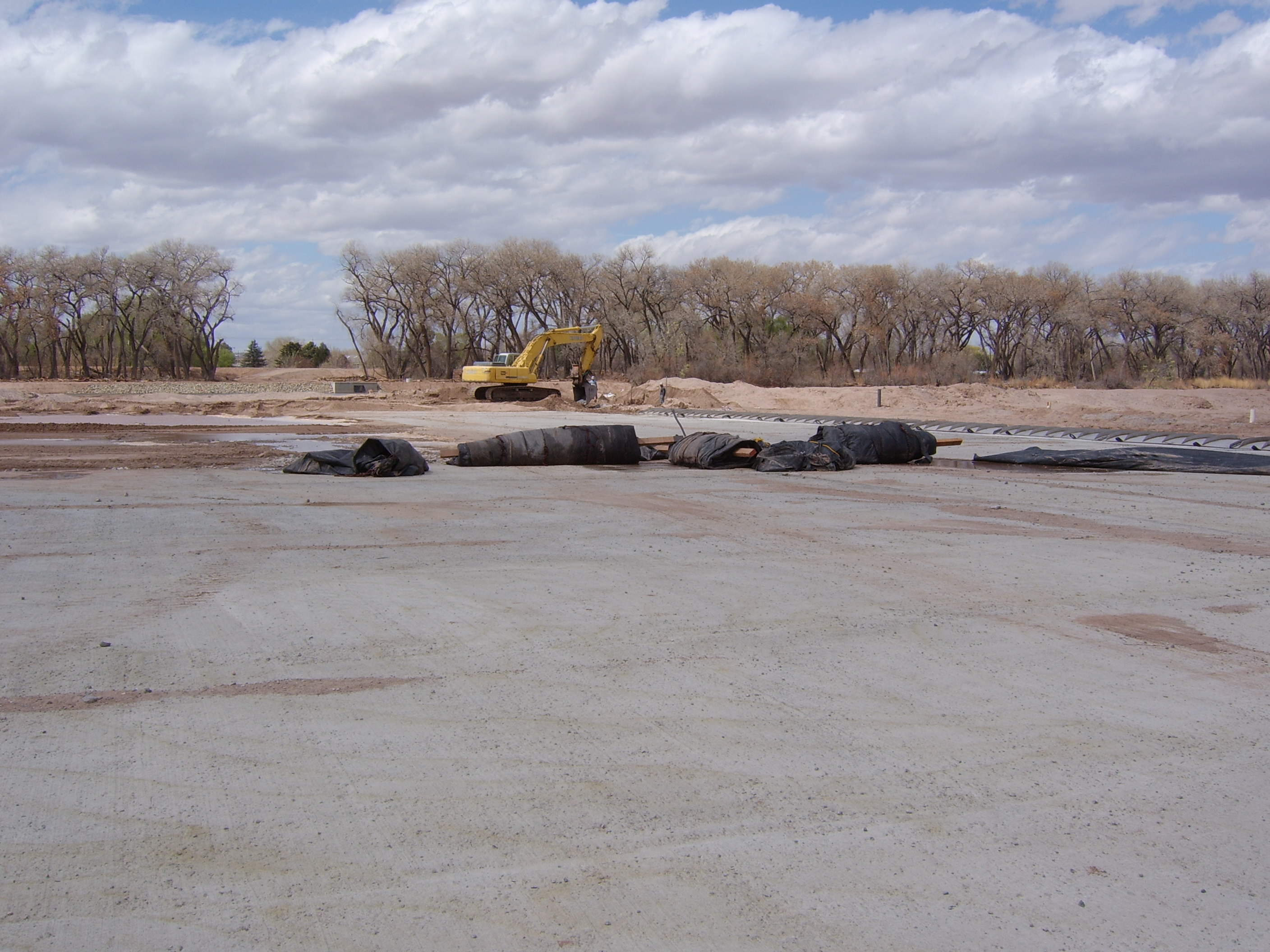
After re-rolling the first set of AquaDams, workers left them in a convenient place to pick up and load on a trailer.
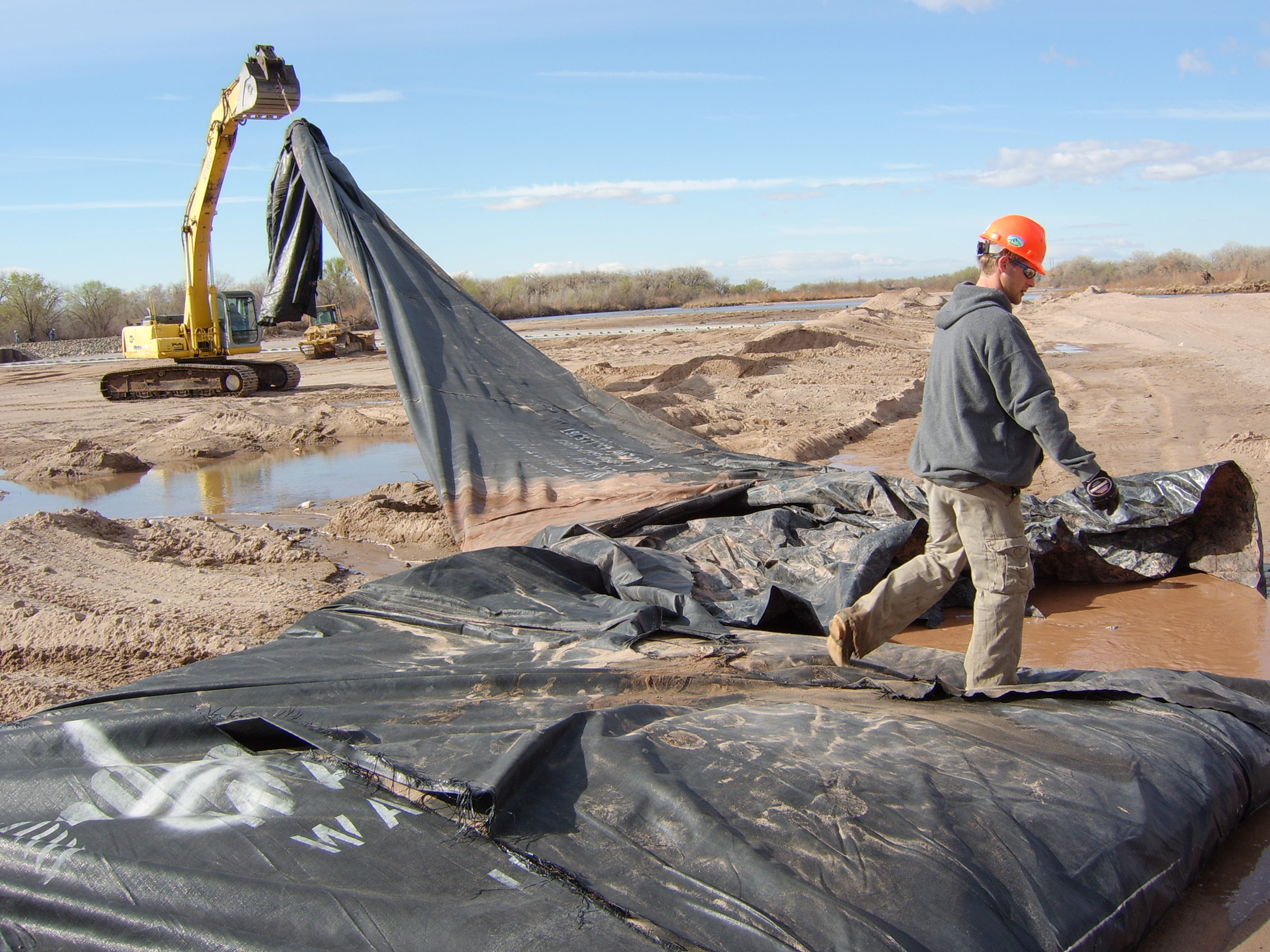
Workers attached ropes to the closed end of the SCE AquaDams, then lifted and pulled on that end to expel the water from the fill-tubes.
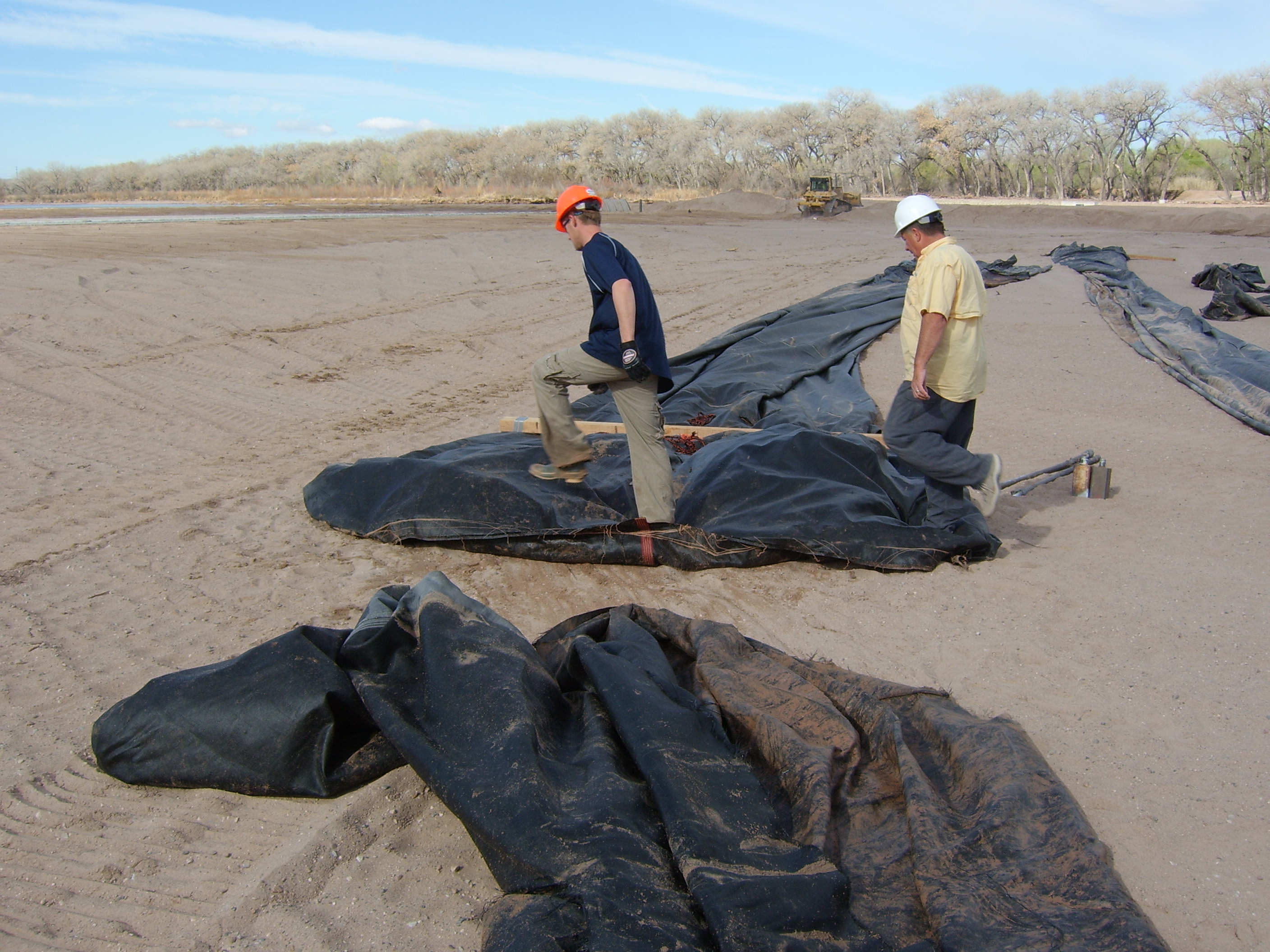
The workers are currently preparing the closed end of the AquaDam® for re-rolling by attaching a wooden beam to it.
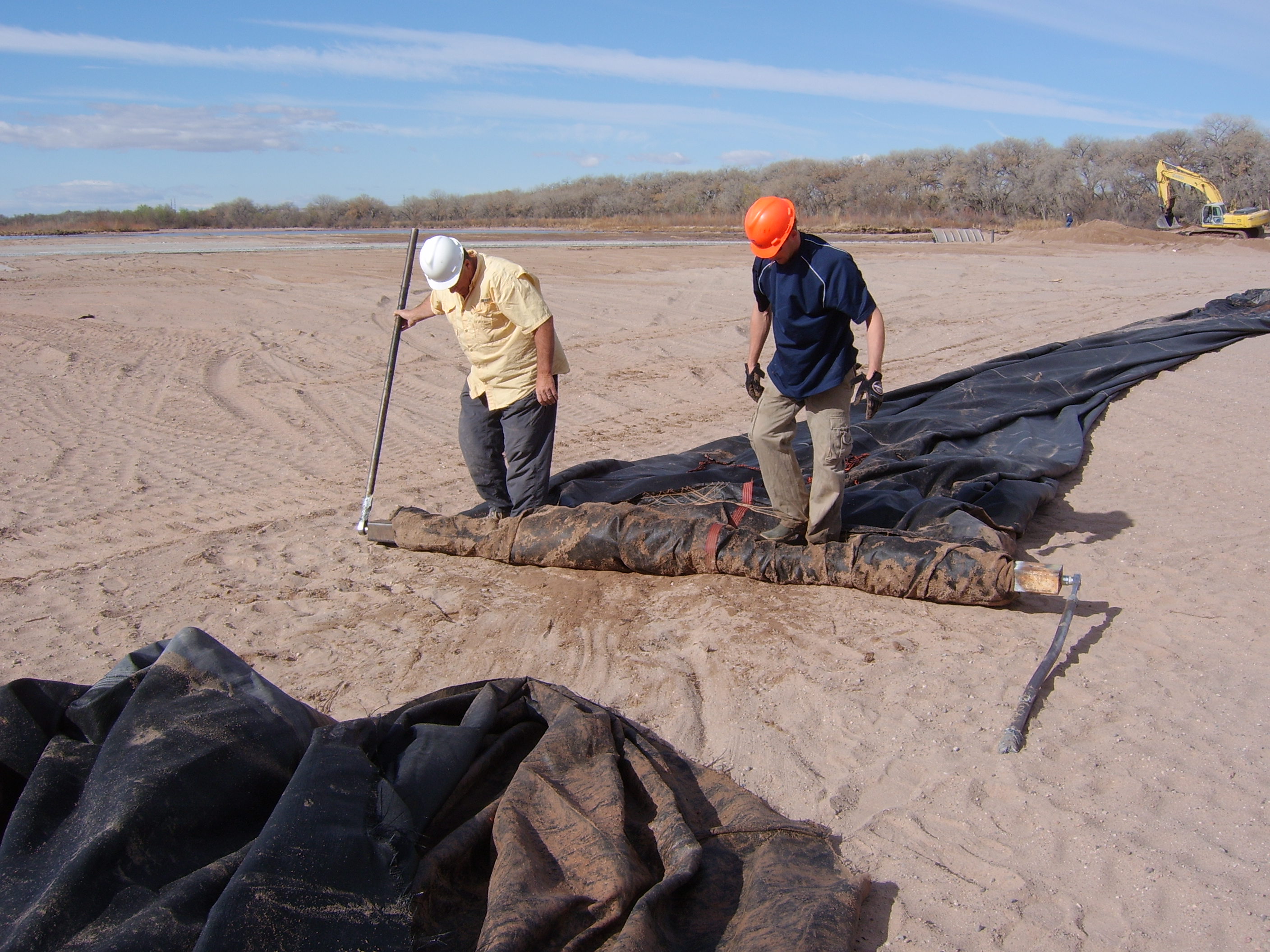
Workers do their best to keep the material in a tight roll as it is re-rolled.
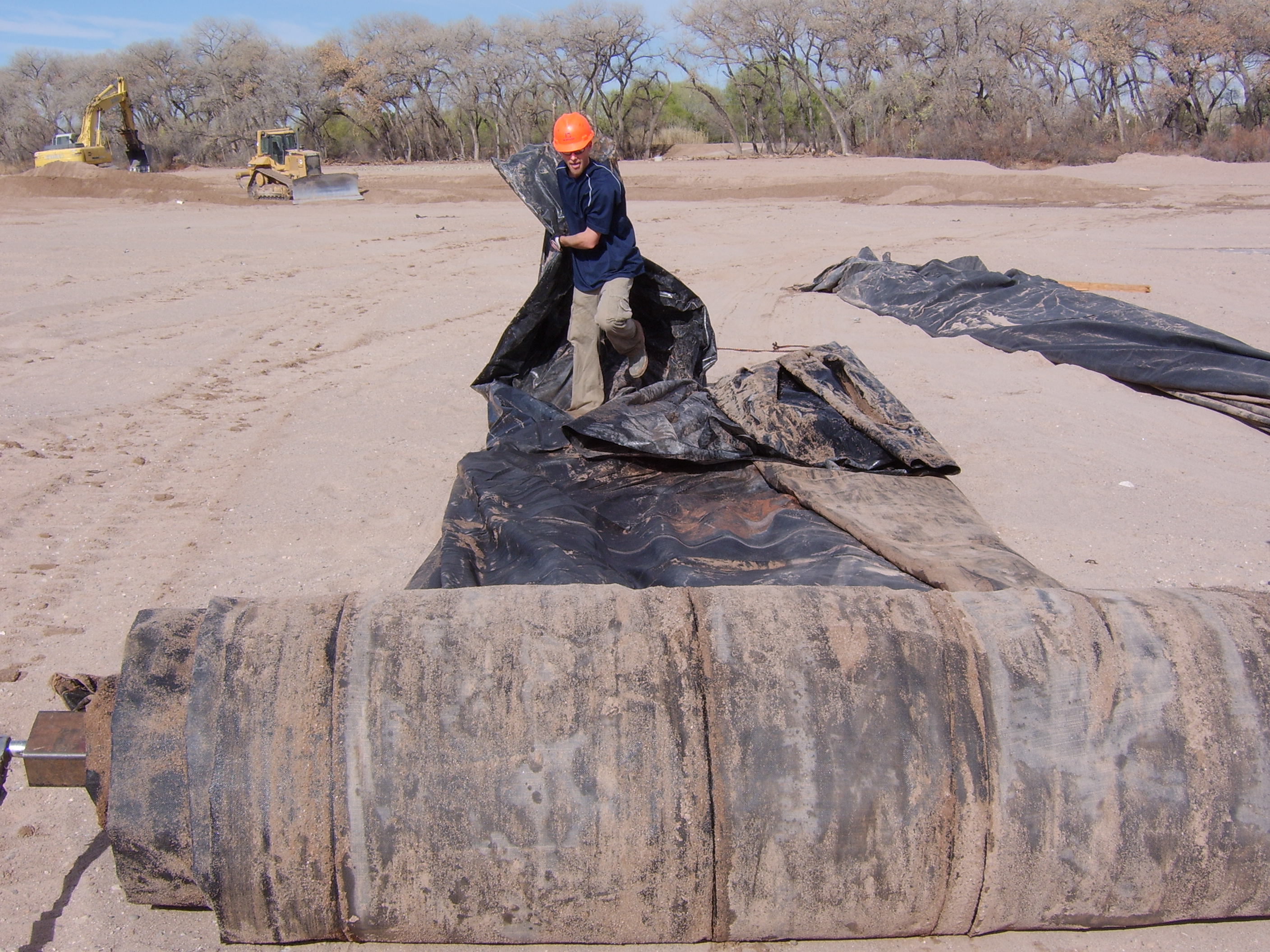
Prior to the roll reaching the open end, workers neatly folded the fill-tubes back into the roll.
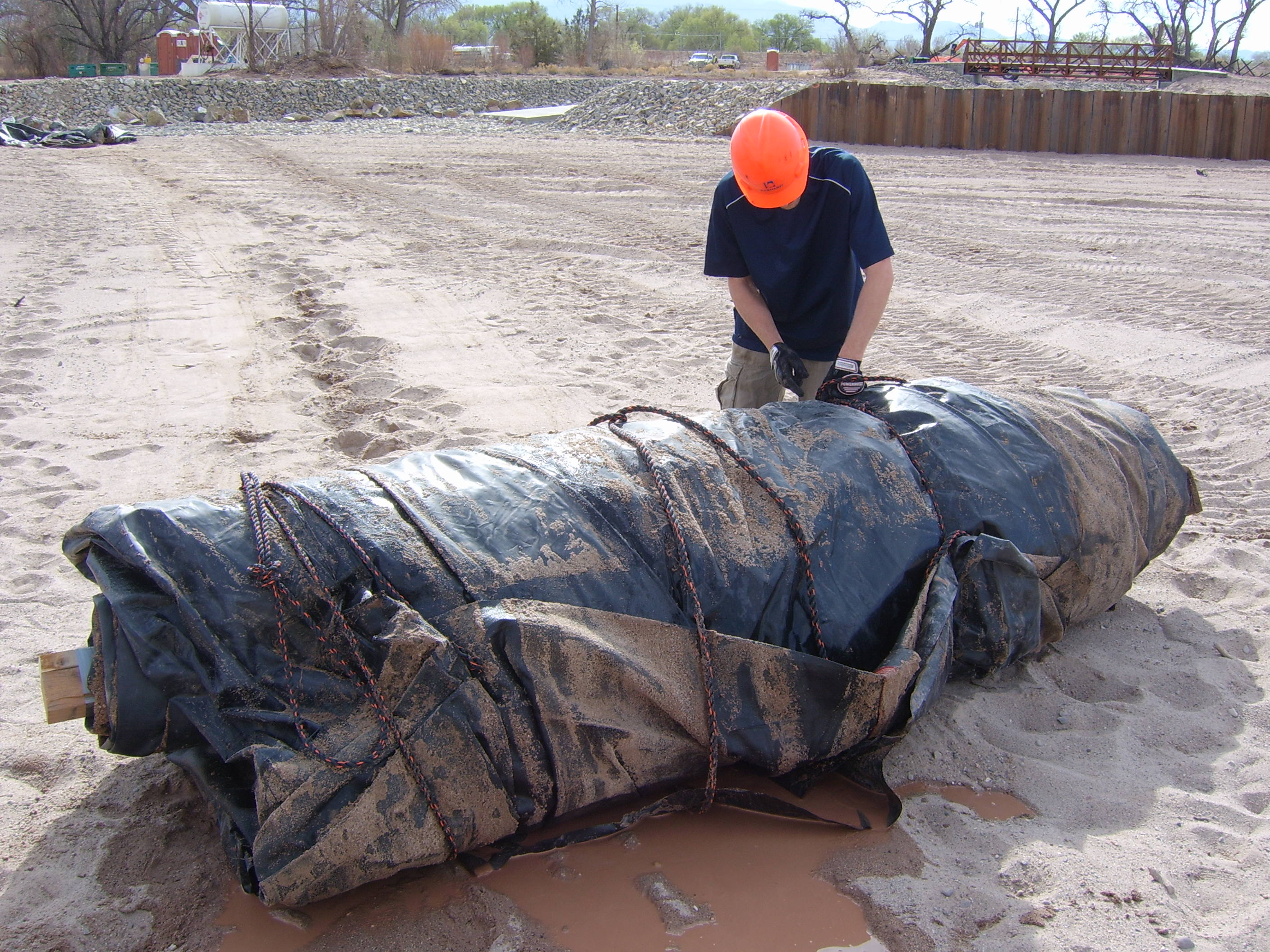
Ropes were secured around the rolls to ensure the material remained in place and facilitate lifting during transportation.

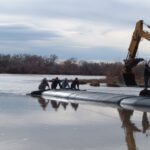
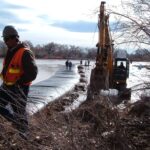
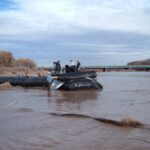
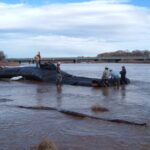
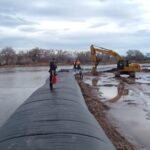
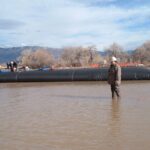
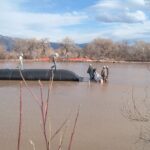
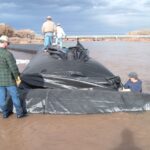
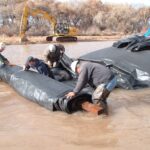
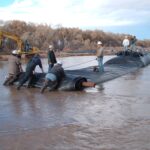
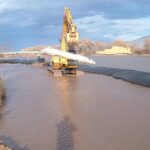

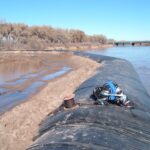

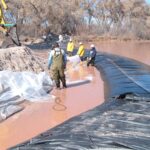
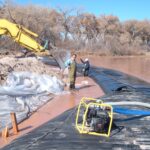
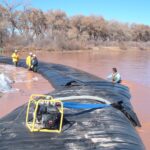
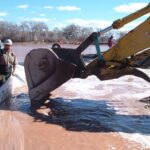
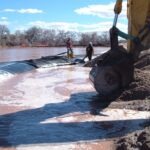
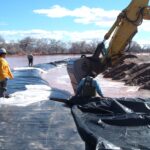
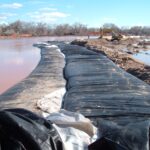

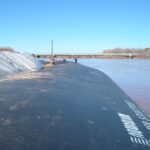
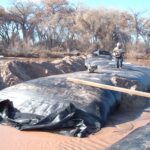
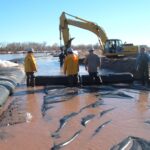
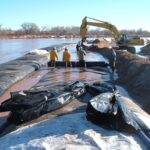
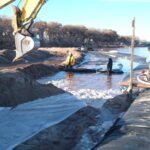


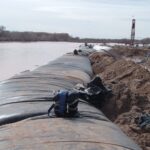
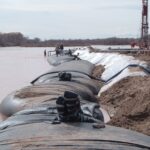
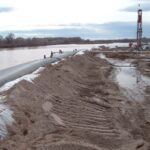
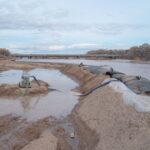
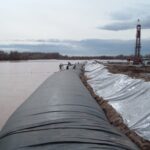


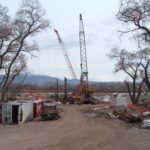


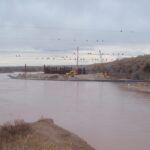
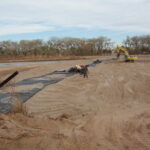
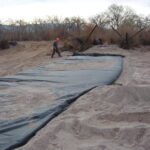
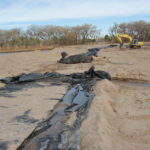
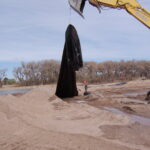

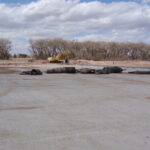
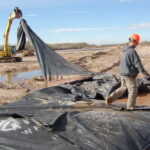
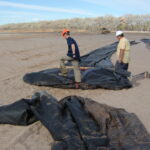
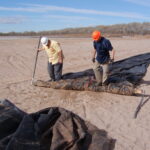
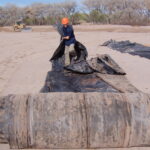
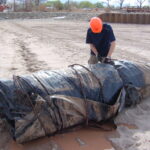
Multiple AquaDams, Shoreline Isolation, Rio Grande River, Albuquerque Bernalillo County Water Utility Authority – Diversion/Intake Facility, Horseshoe/”U” Shape Configuration, Installation – Re-installation – Removal
